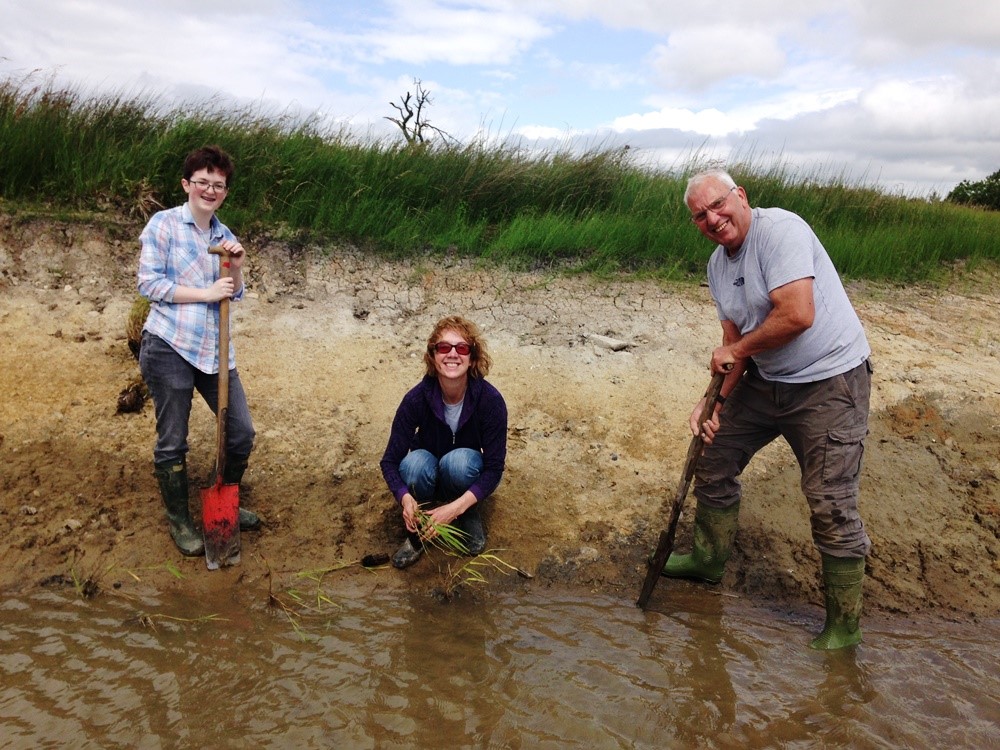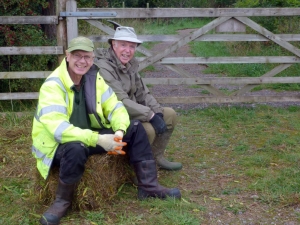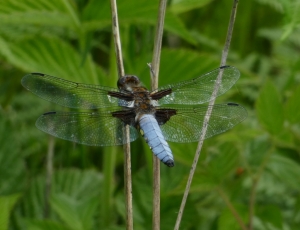Blog Archive (31) Posts Made in July 2018
The Path-works Continue
Tuesday, July 31st 2018
After putting the finishing touches to the aggregate top up carried out yesterday on the perimeter steps we soon cracked on with the path above the steps while the volunteer numbers remained on the up.

First of all it is key to remove all vegetation and soil encroachment into the aggregate before roughing up the surface as the new base layer.

Once the base layer is ready you're ready to rake out the topping and give it a couple of go-overs with the Whacker Plate.

By making sure to sort out any lumps and bumps, and ensuring that there's a good camber the path should be complete…for another couple of years or so.
Buzzards are back!
Monday, July 30th 2018
During our post-storm checks of the Reserve we found yet more evidence that Buzzards bred in one of the conifer blocks at Foxglove.
To begin with I had just one noisy individual voicing its displeasure at my presence.

Before too long it was joined by two more that were if anything, even more noisy than the first!
It's great to see and hear such a heavily persecuted bird over the Reserve and to know that these three are doing well thus far; here's hoping we will see them again next year.

After our post-storm checks were completed it was time to load up the quad bike trailer with aggregates and get stuck into some path work.

First thing's first, clear the entire area of weeds and leaf matter, then and only then can you start laying the aggregate.


With the majority of the job complete I had time to admire the many Bees, Butterflies and Hoverflies on our secret Knapweed patch by the Bullet Catcher.

It was nice to see a Pellucid Fly (Volucella pellucens) again, with its distinctive ivory-white band and dark wing spots. The larvae of this striking hoverfly live in the nests of social Wasps and Bumblebees, eating the waste products of their hosts (including the occasional Bee larvae).
Both sexes prefer sheltered areas, such as woodland rides and tree-lined paths. Males will defend rays of light filtering down through trees, darting off to investigate intruders or females (like the one above) before returning to the same beam of sunlight.
Seeds, Fruits and Fungus
Sunday, July 29th 2018
Once flowers have been pollinated they set seed. Marsh Cinquefoil is only found on the wetland.
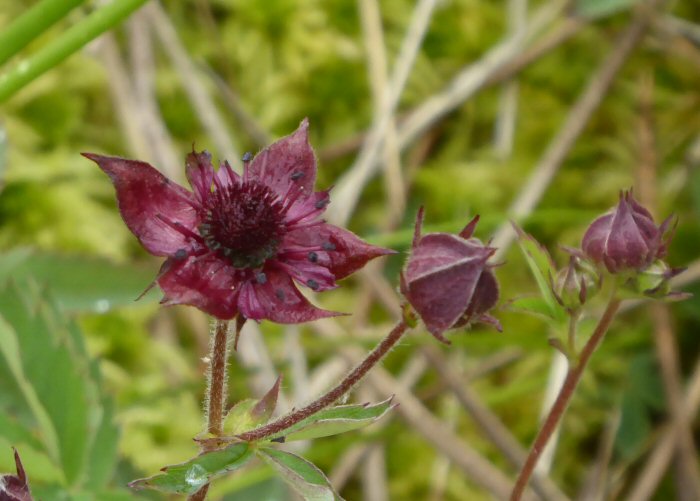
Many different insects can be seen on this flower, butterflies, bees and flies. Whoever does the pollination the seeds have set well this year.
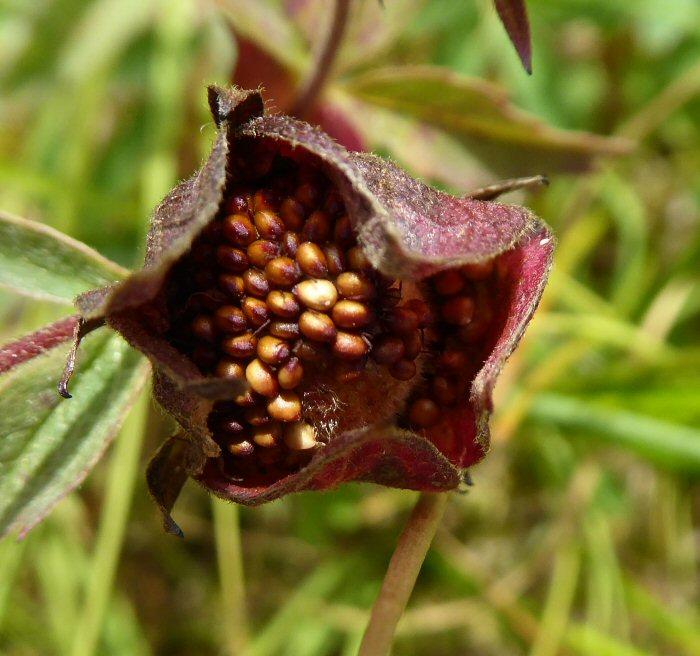
I have to admit that I did not think our Raspberries would have a successful crop, but they have proved me wrong and the stems are covered in ripe, quite large Raspberries. Birds and small mammals will be enjoying the feast.
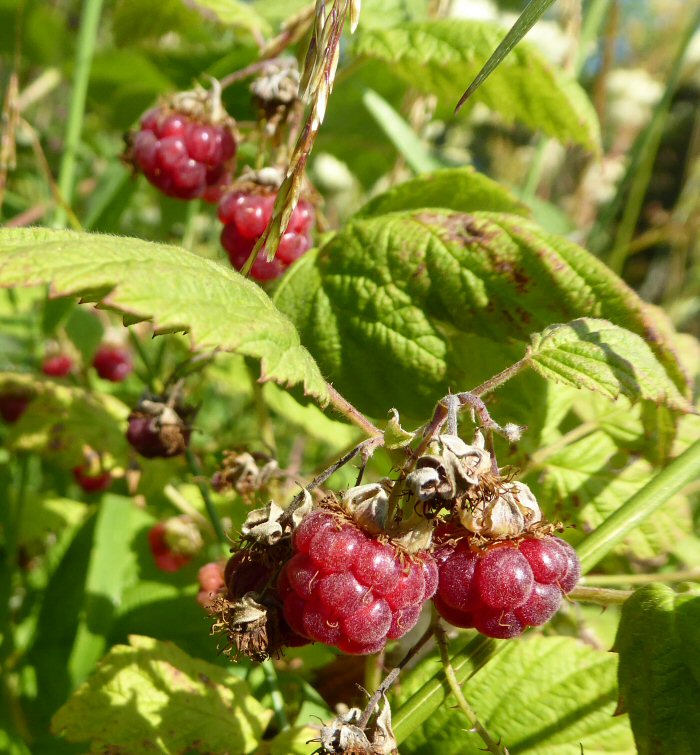
The rain of recent days will help the Blackberry fruits to develop.
Rowan or Mountain Ash is usually one of the first trees showing ripe fruits. Blackbirds and Thrushes enjoy eating these, leaving uneaten pieces strewn across the path.
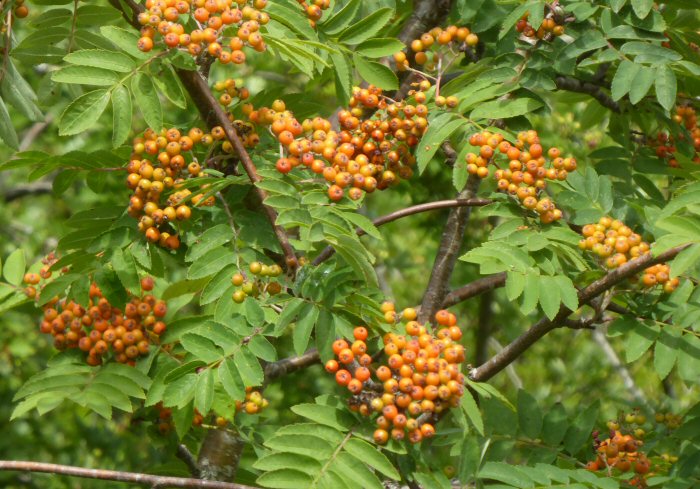
Fungi like warm, damp conditions. We can tick the warm box but certainly not the damp one, until the last few days, but this has not stopped the Chicken of the Woods fungi developing on several of the large logs .
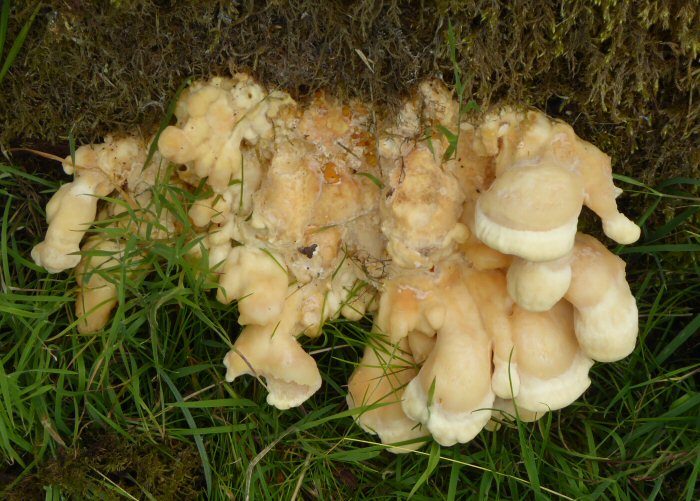
A Variety of Bugs and Beasties
Saturday, July 28th 2018
Our moth trapping continues to give us interesting moths. One that we all know and can never remember the name of, is Buff Arches. It often sits with its wings closed, as shown below.
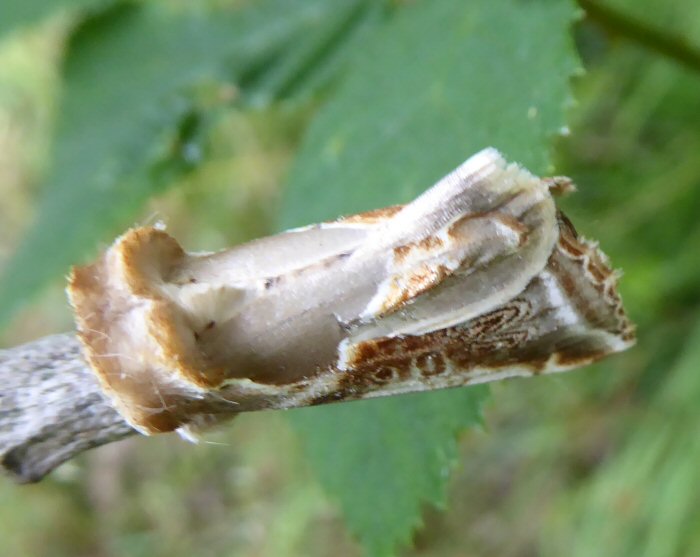
As it has been rather on the warm, sunny side the moths usually do not hang around for long, but it chose to open its wings and sit still so that its amazingly patterened wings were on display.
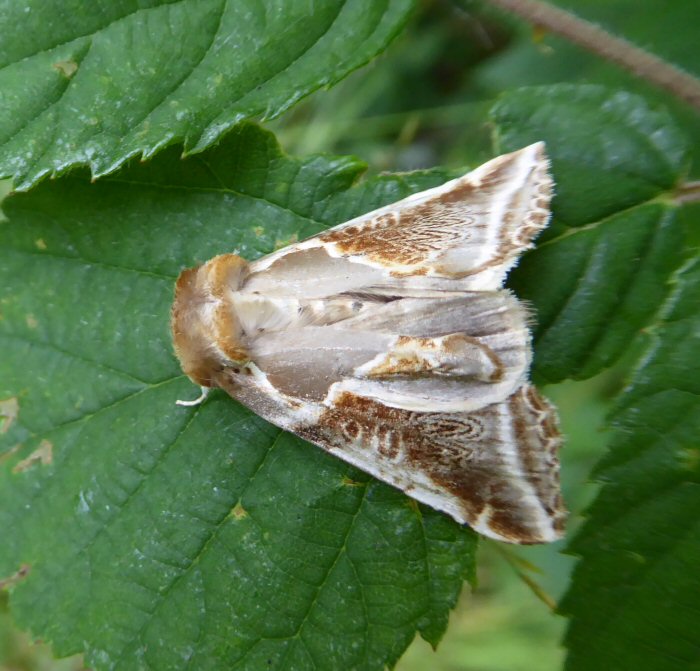
Whirligig Beetles do not sit still for long, living up to their name, whirling around, very fast!
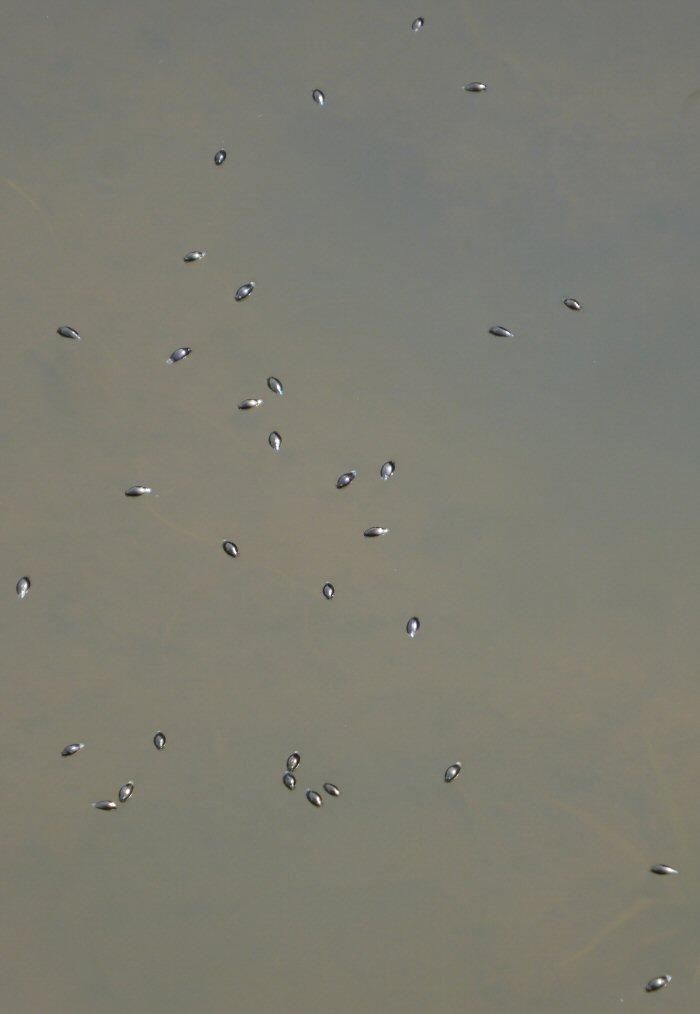
In the sun, the damsels were dancing, settling on the vegetation for a short time before taking flight.
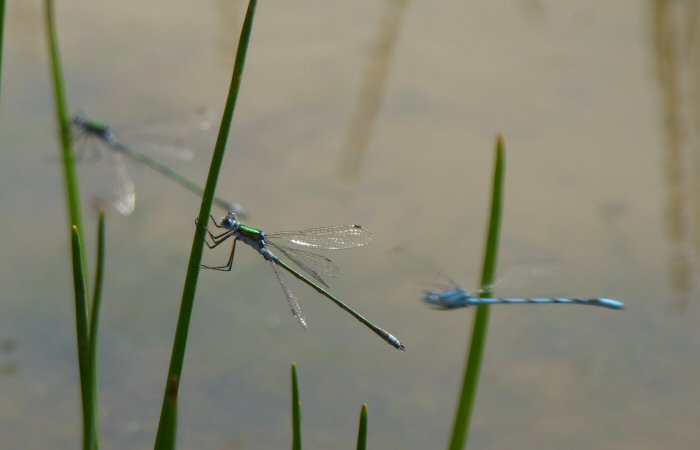
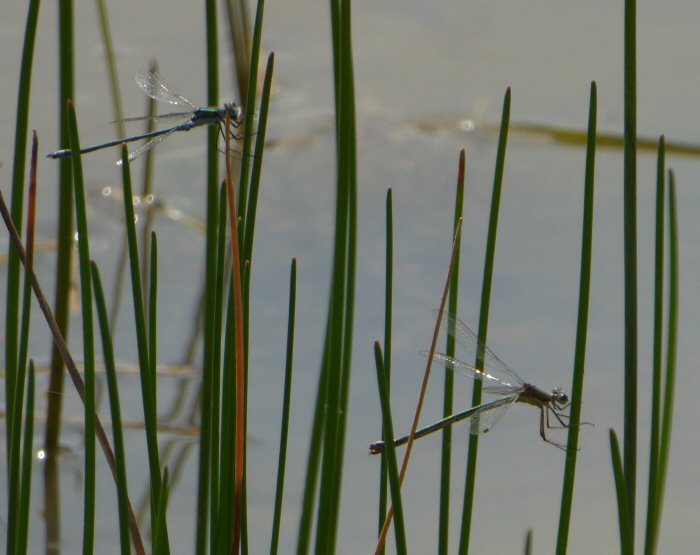
Some years Green Leaf Beetles can be found covering almost all the leaves on Alder trees and many other plants. This year they are far and few between. Inspecting the leaves, as one does when a hole is seen in it, a larva was found.
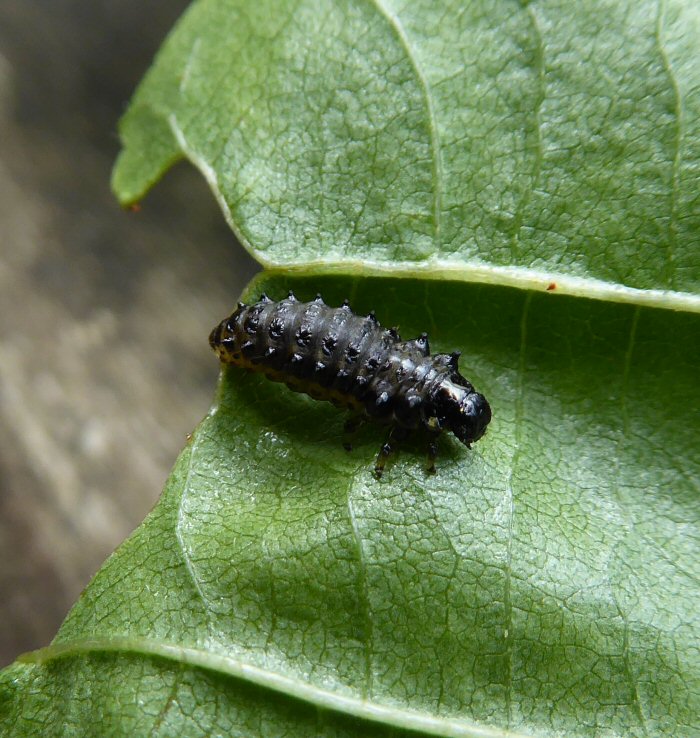
On another leaf a pupa was seen.
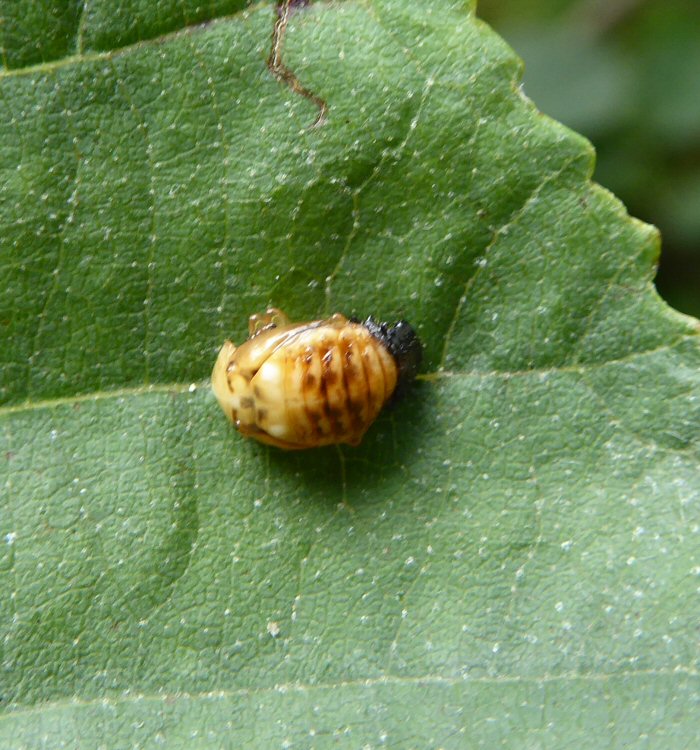
And finally the adult.

All of the above are insects, with three parts to the body and 6 legs. It is coming up to spider time! These invertebrates have two parts to their body and four pairs of legs.

If you want to find out more about all the lovely bugs, beasties and creepy crawlies that live at Foxglove, then the events on Wednesday 1st August will suit you very well. Check out the Events Page or contact the Reserve Managers, for more details and to book your place.
If moths are your favourite, then the moth morning on Saturday 4th August will be just right for you. Again visit the Events Page or contact the Reserve Managers for more details.
Half a Day for Ducks
Friday, July 27th 2018
Don't get me wrong I'm very happy that we've finally had some rain, however with rain comes exponential plant growth and vegetation encroachment onto the net rides.

Despite having only been cut on Tuesday many of the Net Rides needed some work again today as I made my way around topping up the reserve's many bird feeders.
On the plus side the heavy rain that came in just before midday certainly didn't bother the huge quantity of ducks on the Lake.

In the ten minutes in which I sheltered from the heavy rain I spotted 18 Mallards, 7 Tufted Ducks, 6 Moorhen and 4 Little Grebe, all seemingly enjoying being out on the lake in the rain.

We might not have had a full day of downpour as promised but what we have had has been most welcome!
As a side note it is worth mentioning that due to the forecast this weekend Bird Ringing will not be taking place on Sunday (29th) and will instead take place later next week.
Cutting, Pulling and Copper-coloured butterflies
Thursday, July 26th 2018
Continuing on from yesterday's reed cutting we worked further up the boardwalk on the Scrapes and finished cutting and dragging from Net Ride 36.

After finishing off the last Net Ride in need of cutting this week before CES 9 on Sunday we cleared the path round the back of the reed bed in the baking hot sun, taking regular breaks in the shadows of the nearby trees.


Today was all about tidying up and finishing jobs off before the end of the week, so next we headed over to the Hay Meadow to remove the last of the thistles in preparation for the hay cut next week (weather permitting). It doesn't take long to realise just how spikey Marsh Thistles are, with a fair proportion of their fine needles making their way through thick leather gloves with ease!

It was great to see an abundance of Small Copper (Lycaena phlaeas) butterflies up on the Hay Meadow, although this wasn't altogether surprising given that this elegant little butterfly's prefered habitats are unimproved grasslands, heathland, woodland clearings and moorland (things that we have in abundance here at Foxglove).

The Small Copper caterpillar's main foodplants are Common Sorrel (Rumex acetosa), Sheep's Sorrel (R. acetosella), and Broad-leaved Dock (R. obtusifolius); with males of the species being very territorial, often basking on bare ground (like the one above) in wait for passing females. Indeed, the males can be very aggressive towards any passing insect, and will chase them away before returning to the same spot.
Wonderful Water
Wednesday, July 25th 2018
For today's Wonderful Water event I gave a number of options, with Dam building, Pooh sticks and Pond Dipping proving most popular.
After spending some time discovering the way in which water will flow past (and often through) obstacles, we took a leisurely walk down to Risedale Beck to play Pooh Sticks and to take a look at the old Mallard nest by the bridge.

Continuing on along the Green route, past the Ponies and Heathland we made our way to the Scrapes where we tried our hand at Pond Dipping before taking some of the things we caught along to the Rivers 2 U Lab parked up at the lay-by.

We spent the rest of the event learning all about leaky dams, Beavers and bank stabilisation courtesy of the Yorkshire Dales Rivers Trust mobile 'Rivers 2 U Lab', which will be making a return to Foxglove on Wednesday 22nd August for all those that missed it today.


The rest of the day has been given over to numerous odd jobs including strimming the verges of the boardwalks down through the Scrapes and Pillwort translocation from the Wetland onto Plovers Pool.
Heaths, Hedges and Hay Rattle
Tuesday, July 24th 2018
We've had people working all over the reserve today, from cutting net rides, to trimming hedges and removing encroaching vegetation from the Heathland paddocks, it has certainly been a busy day at Foxglove.

The Heathland will need continued maintenance until later in the year when we can stump treat the old willow stools, until then we have Eddie and the new Stihl clearance saw!

On top of all these other activities we've also made a start on removing thistles from the Hay Meadow and collecting Hay Rattle seeds ready for sowing later in the year and selling right now in the Field Centre.

At £1 a sachet this is an absolute bargain, just sow the seeds on bare ground in the autumn and let the Hay Rattle do the rest!

Pillwort Assessment
Monday, July 23rd 2018
Anne Heathcote from the Freshwater Habitats Trust led today's Pillwort survey, and after a disappointing start surveying a couple of ponds on the Military Training Estate we had a lot more success in a couple of the Wetland ponds on the Reserve.

After the initial assessment we soon realised that the Pillwort was actually spreading in the ponds in which it was originally found, and that a little bit of pond gardening would go a long way toward encouraging further growth in these areas.

After spending time removing rushes and typha by hand in order to reduce competition for light and space, a small amount of Pillwort that possessed pills was removed for propagation and future translocation to suitable ponds nearby.

Anybody interested in propagation and/or translocation of Pillwort is welcome to come along to one of our Pillwort Translocation events on Monday 6th or Monday 20th August.
Bempton Cliffs and Little Things
Sunday, July 22nd 2018
Some of the bird ringers have been involved over the weekend fitting trackers to Gannets at Bempton Cliffs. The trackers will record the movements of the adult birds and this year are much more refined with special cameras set into the cliff tops recording the movement of the adults as they come and go to feed their chicks. The cameras can identify the birds individually once the trackers are fitted.
It requires a great deal of organisation for this to be carried out. However one thing is similar to our CES at Foxglove, they had to be up at dawn! A familiar face can be seen below but as you can see from the t shirt , she has, temporarily we hope, gone over to the dark side!
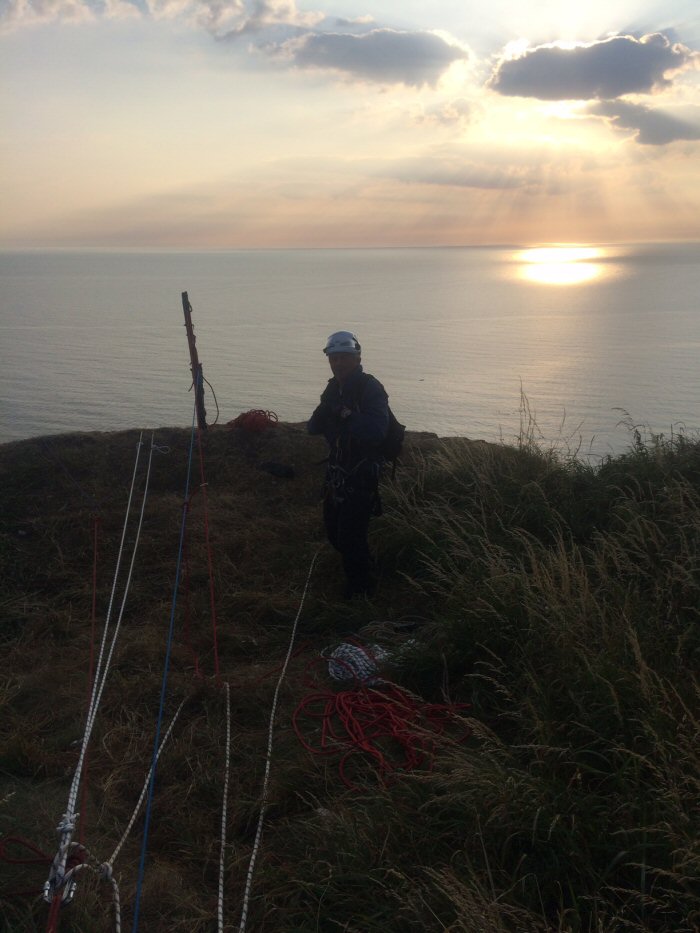
Two new problems presented themselves this year, one was the number of Gannets that now breed on the cliffs at Bempton - which are far in excess of what they were when the earlier studies were conducted between 2010 - 2012. The second was the damage 'the Beast from the East' had caused to the cliffs themselves making them much more unstable and difficult to move on without dislodging lumps of stone. Both had to be given serious consideration by the climbers and necessitated an earlier than planned halt to this year's activities.


From large birds to tiny weevils. Water Figwort grows through the Scrapes and it must be admitted that it is not the most beautiful of flowers. It does have its own weevil, the Figwort Weevil. Several were found on stems.
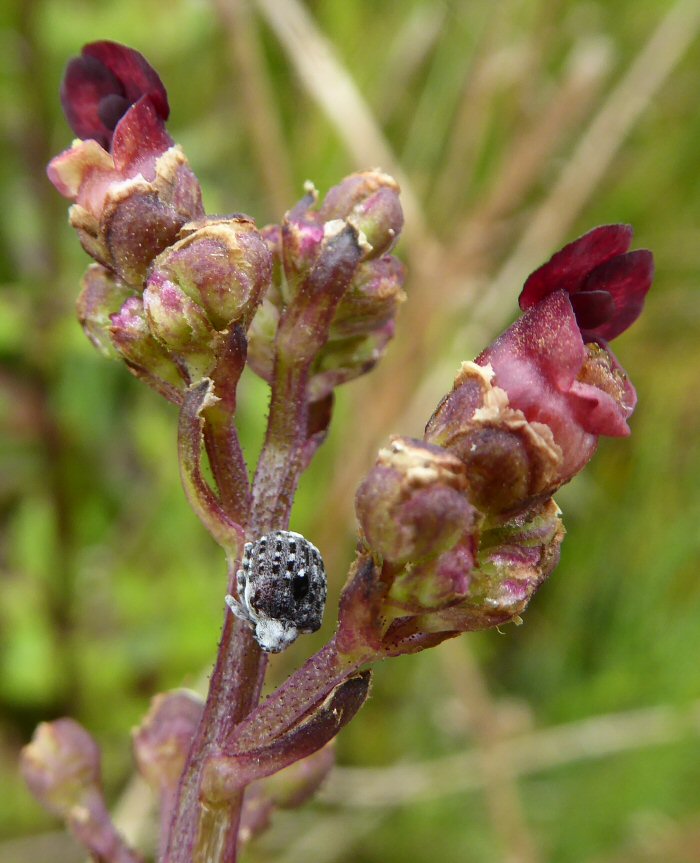
Another interesting fact is that only Wasps pollinate these flowers. I have tried for several years to take a decent photograph showing a Wasp on the flower. Success at last.

Moths, Dragons and Damsels
Saturday, July 21st 2018
Moths are not a favourite of some people, but they are a delightful group of creatures. Amazingly they sat still for photos, instead of disappearing.
Barred Straw is often one that takes flight. The larvae feed on bedstraws, of which there are plenty across the reserve.
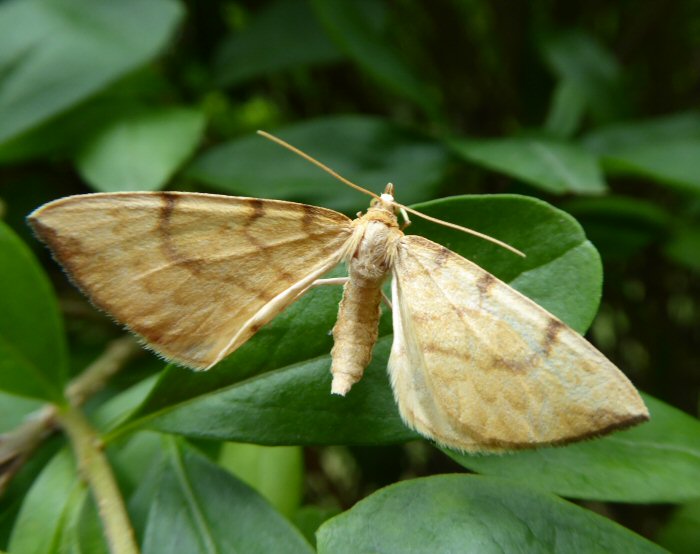
Some moths never vary in colour or pattern, but Common Rustic does. This one had me searching through the book initially.
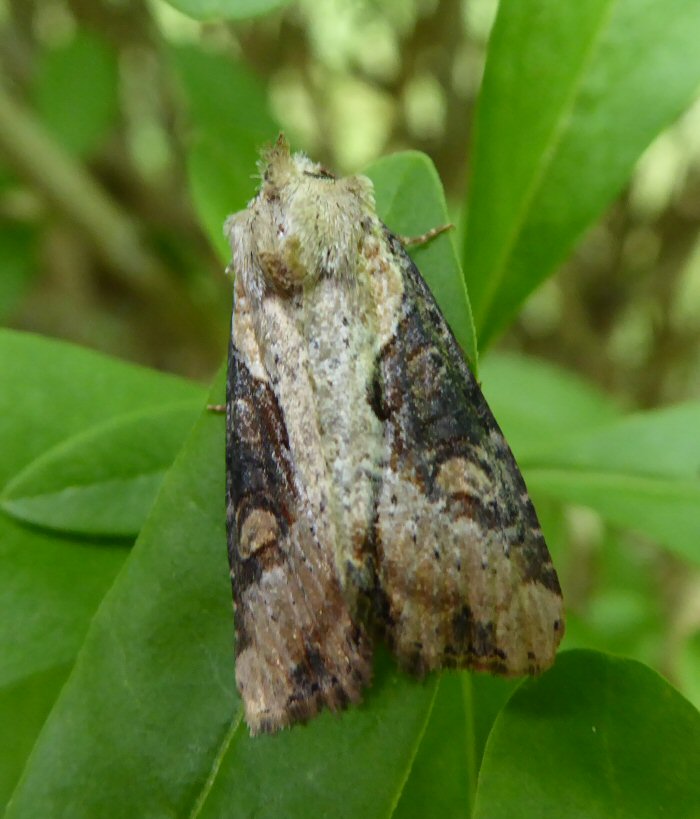
Who could not love this furry fellow - Iron Prominent?
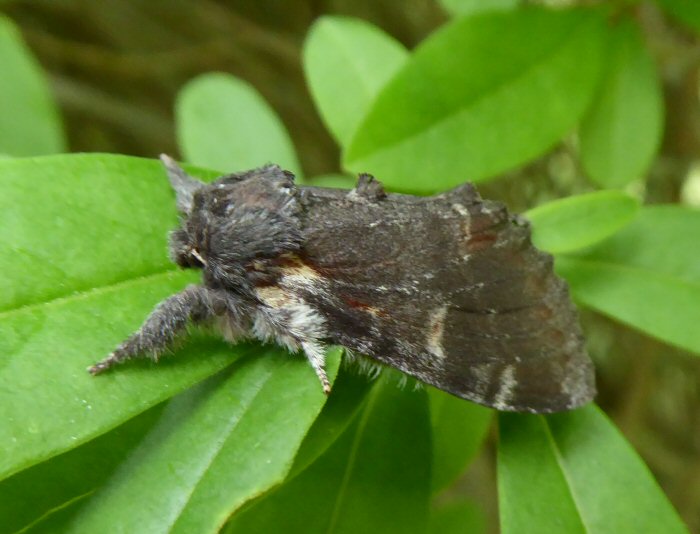
Mother of Pearl is a beautiful moth. Its larvae feed in a rolled up leaf of Nettle.
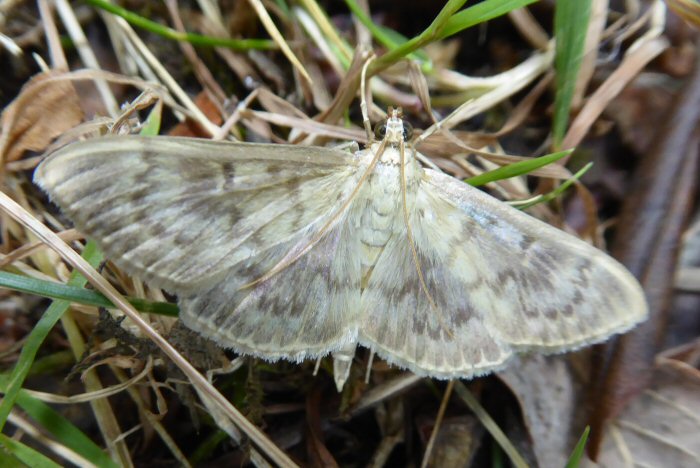
We have had several notable 'Dragon and Damsel' walks with Keith and June. One had temperatures of 11 degrees, another the wind was blowing so strongly we were almost blown over and yet another was very, very wet! Today was not ideal but it was warm, dry and no wind, the only thing lacking was sunshine. However we were able to see a surprising amount.
The orchard is an excellent place for dragons and damsels to hunt. The first caught was an Emerald Damselfly, which Keith showed to everyone, informing them of the colour changes that take place between emerging and maturity.
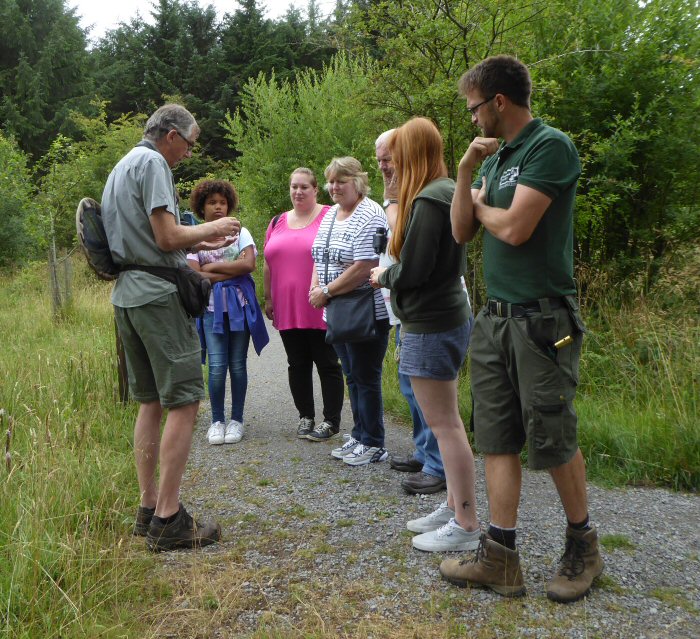
The wetland provided us with sightings of Common and Azure Damselflies and a Black Darter. Unfortunately the only photo I managed to take was in the hand, this being the correct way to release them.
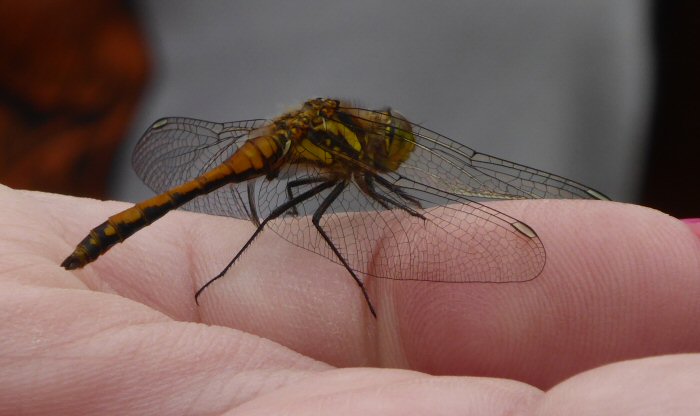
In the Scrapes a large dragonfly was spotted. It was hunting around the small pond so those with nets set out to see if it could be caught. Nets nil, dragonfly one!
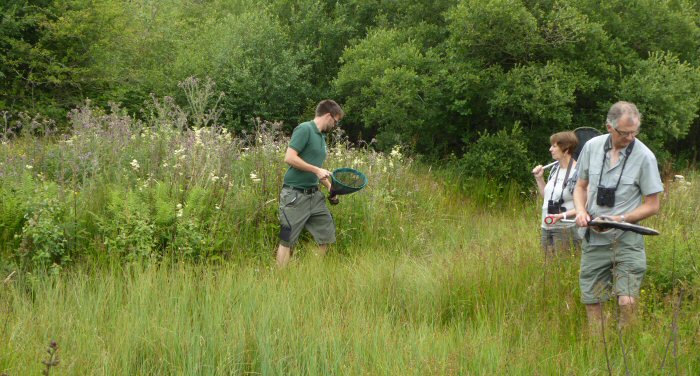
We followed it through various parts of the Scrapes to no avail, but it was probably the Golden-ringed Dragonfly that I had spotted earlier in the day. So often these insects come to have a good look at you, decide you are too big to tackle and fly off, leaving you with not even a splodge! This one sat absolutely still on Purple Loosestrife. It was definitely being in the right place at the right time.
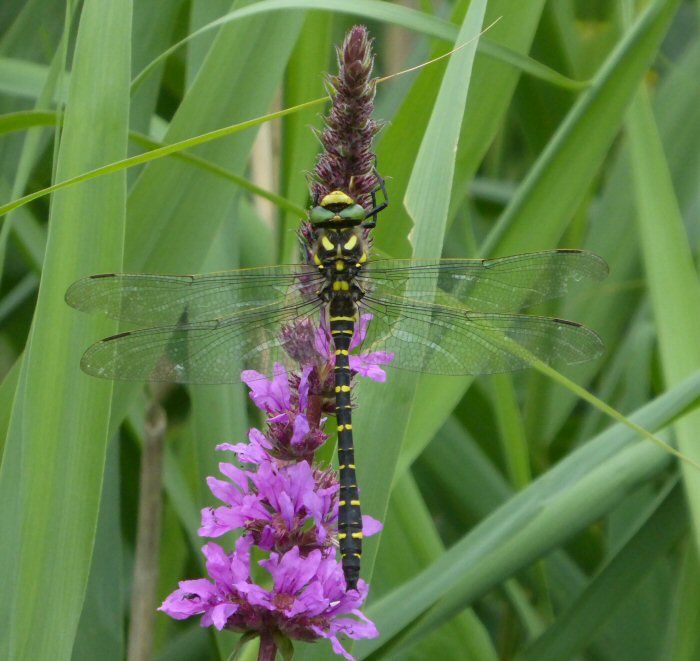
Keith and June gave much information about the various dragons and damsels we saw. Everyone enjoyed the walk and the discussions. Many thanks to Keith and June for leading this walk.
A Good Morning for Peacocks
Friday, July 20th 2018
The warm weather continued this morning, so the first thing would have been a check on the ponies to see how they had settled in their new compartment on the Heathland but this had to wait as work was going on to repair the Access Gate. Once this was working, it was time for Lark and Taurus who were both sufficiently absorbed in the plentiful supply of grass to just raise their heads to see what was going on before returning to grazing.

Newly emerged Peacock butterflies (Aglais io) have been on the wing. Those seen previously this year were the ones that had over-wintered in hibernation, with many looking bedraggled and with faded colours. Not so those today which are resplendent in bright colours and eye spots. Having spent the early Summer as caterpillars feeding on Common Nettle (Urtica dioica) followed by the last few weeks as a chrysalis, they join the Brimstones and Red Admirals seen this week.

The dry weather also meant that Colin could finish the tunnels on two of the Mink rafts. We have designed these with hinged lids which will make it easier to see the clay cartridges in the tunnels and look for footprints of Mink (and Water Voles). He completed the second and third new raft, so we still have more to make and refurbish a couple of the old ones.

Colin then spent the afternoon filling the bird feeders, which meant it was time for me to make up one of the clay cartidges to fit the new rafts. These come as a kit with a shaped basket, a floristry reservoir, clay and sand.


As the basket sits in the water, the reservoir has to be shaped to fill the basket to just under 10 mm below the basket top. This will remain wet when on the raft which will them also keep the clay mix damp enough to take footprints. Having mixed the clay and sand with water, this was spread out over the top of the basket and smoothed ready for use in the raft on the Scrapes. Hopefully, we'll get some results in the next few days.
Good Housekeeping
Thursday, July 19th 2018
With no schools or goups booked in for today, it was a good opportunity to catch up on a number of jobs. The boot brushes at the entrance to the Field Centre have seen sterling service but have gradually become worn down, so all four brushes were replaced this morning.
While it is unlikely that they will be put to use in the next few days, this is a small addition to the welcome for visitors to the Centre. The sunny weather has meant that we have had quite a few visitors today who have called in at the Centre and one was very pleased to be able to use the mobility scooter to explore the reserve.
The small group of volunteers have been working on the platforms and buoyancy for the final two of the four Mink rafts that are being made. These should be finished tomorrow with a couple of them going out on to the reserve to replace the older ones. The main task has been to attach the wire mesh at either end of the platforms to hold the floats and to give purchase for animals climbing onto them from the water.
There was also a short break to help Taurus and Lark move from the Heathland compartment they have been grazing for the last week to start work on the grass in the next compartment. They didn't need much persuading and quickly made the move once the gates had been opened for them.
Judging by the mouthfuls of grass they had already eaten in the first five minutes, they will quickly make an impact in here. A picture from around the same spot in a week to ten days' time should show how good a job they are making of it.
A Busy Species Day
Wednesday, July 18th 2018
The moth-ers identified the moths collected from the trap. Some were easy to ID, some proved a little more difficult, so the books were out and everyone voiced their opinion until the correct ID was arrived at.
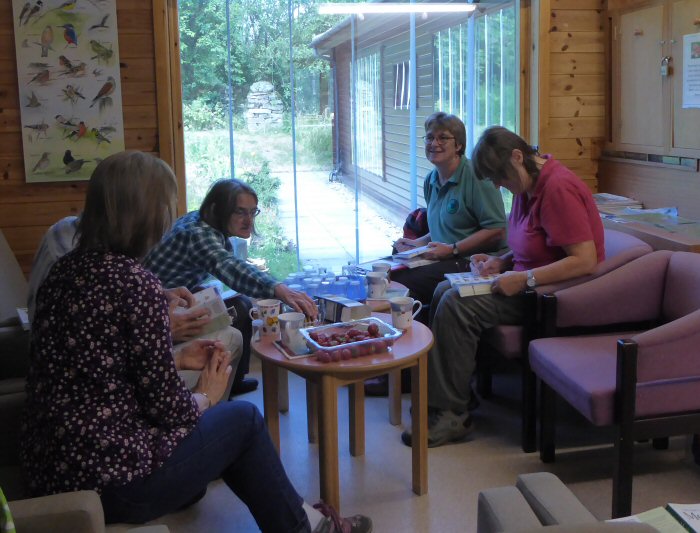
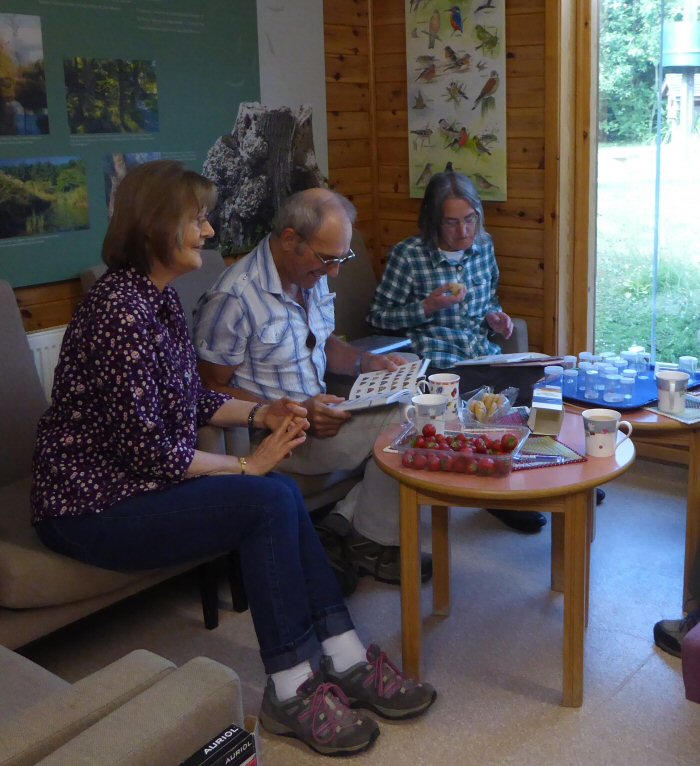
Next, photographing those that we wanted, which usually means moths 7 photographers 2, as they fly off. We were lucky that we had caught five Scalloped Oak moths so we felt that we would be able to photograph at least one. The first one out of its container sat perfectly.
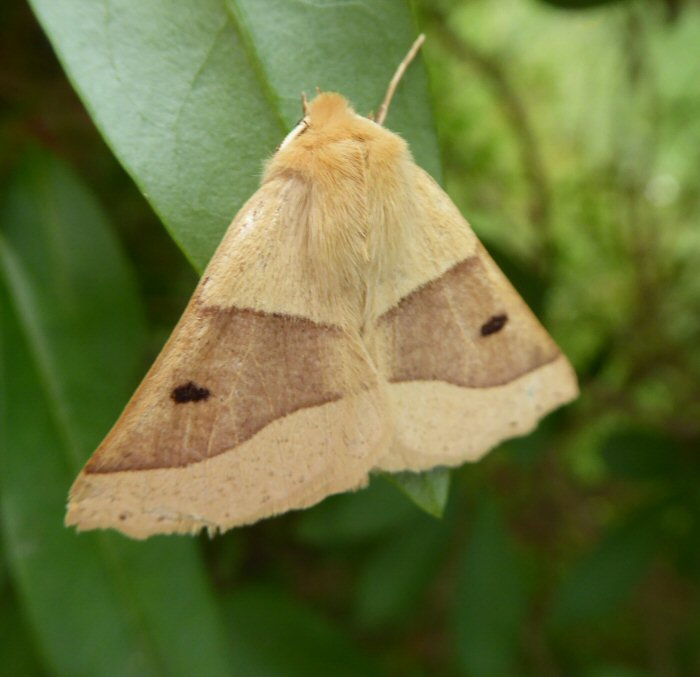
The next one just showed off, hanging onto a leaf with only one leg.

Our work was not done. The Rivers 2U bus is coming to visit next week (see events page for more details) so we set off to explore what we could find in Risedale Beck, which is not a frequent activity. As usual when we go 'walkabout' we were soon waylaid by droppings. After consideration we decided that they were Otter spraint, but a final test was needed, a good sniff! If it smelt of citrus then it was Otter, which it did.
.jpg)
'Pond dipping' in the beck caught many mayfly species and
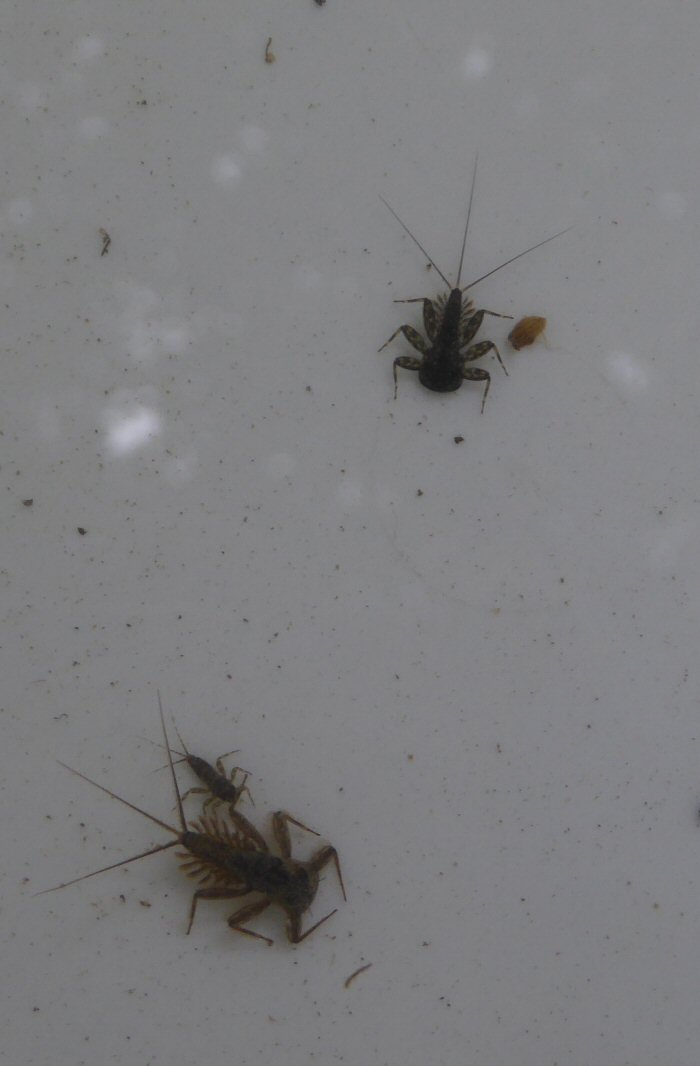
caddis larvae. The caddis species found in the beck are different from those in the ponds. This one had used quite large pebbles for its case, fixed to a small rock.
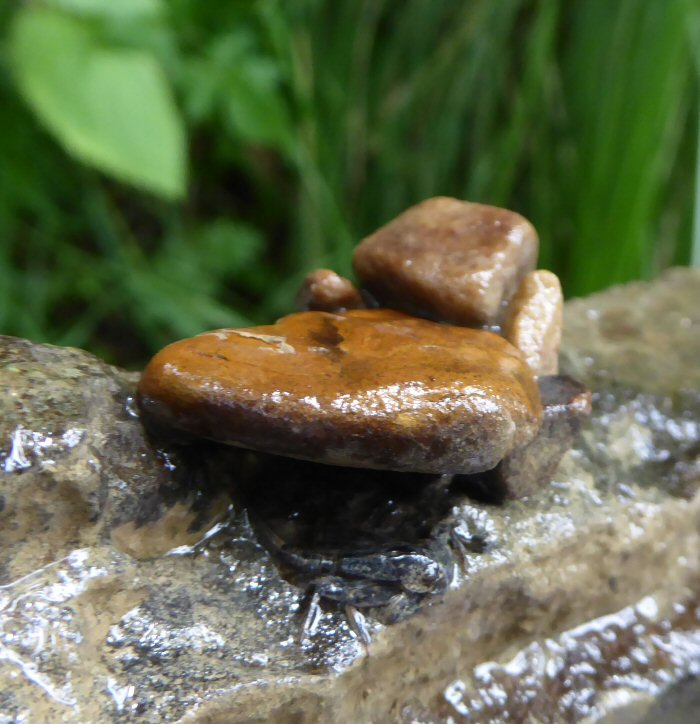
Back to dry land, a Dark Green Fritillary sat on a Knapweed to feed.
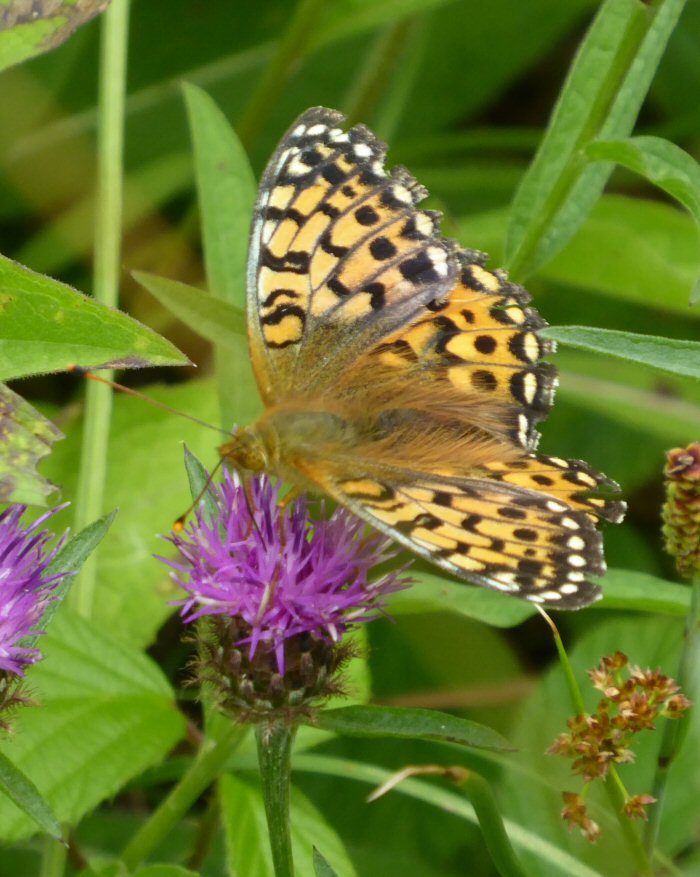
Later in the day a white butterfly was seen that had a patterned underwing so a closer look was carried out and with reference to a butterfly book we confirmed that it was a Green Veined White.
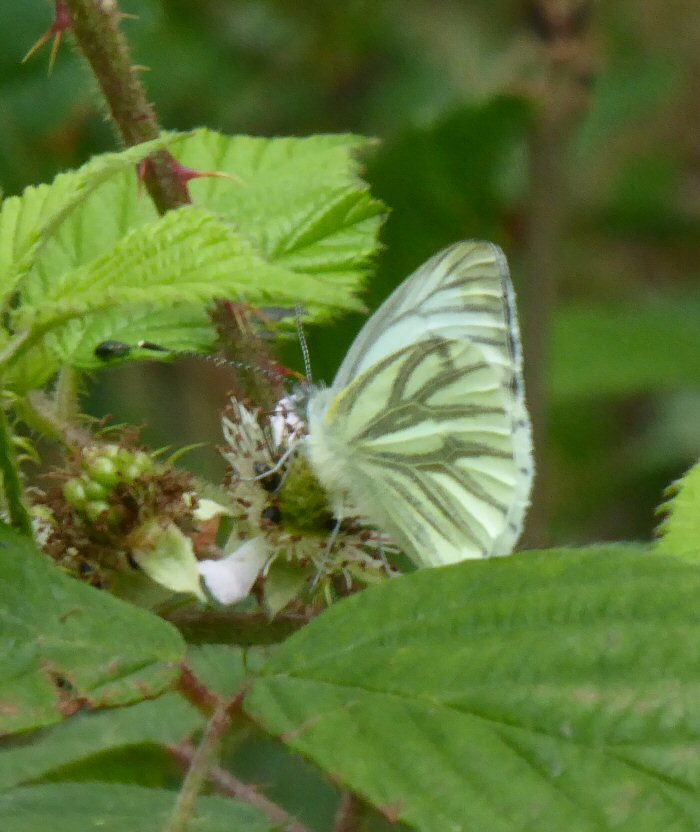
Whilst looking at the butterflies we realised that we were surrounded by Cicadella viridis, delightful little frog hoppers who were certainly living up to their name.
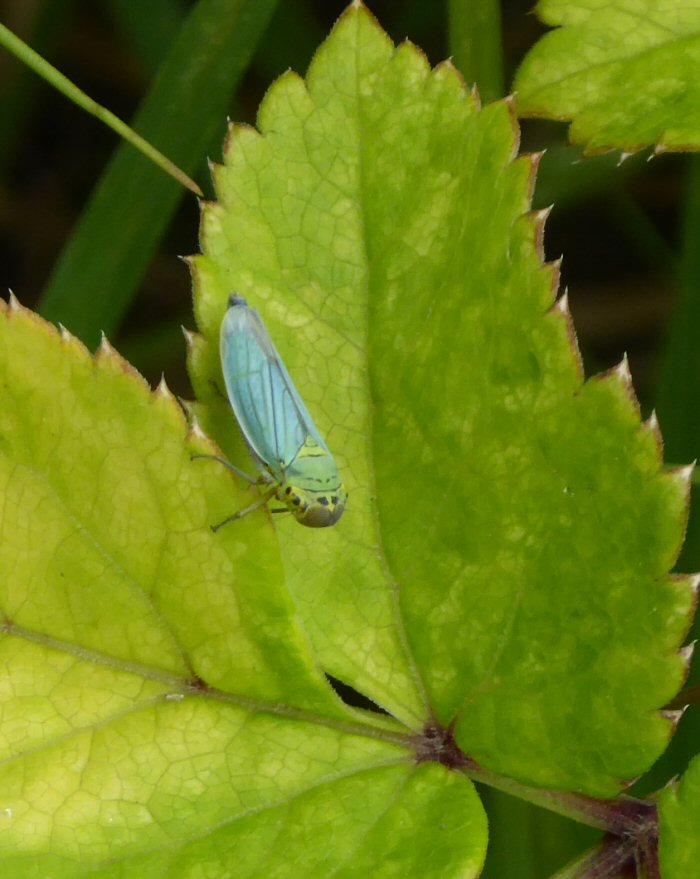
Many thanks to the volunteers who helped find species, ID species and enter data into the Species Programme.
A Visit by BEES
Tuesday, July 17th 2018
WIth the thunderstorms and very heavy rain late yesterday evening being followed by another downpour early this morning, there was hope that the water levels around Foxglove would have risen. And indeed they had, given the flood of water rushing through Risedale Beck.
Obviously, it will take time for water to work its way through the system off the surrounding moorland. We should see some rise in levels over the next few days which will be particularly welcome on the Wetland wher the flow into the ponds has been significantly reduced recently.
There were four volunteers in today, carrying out some of the tasks associated with recent rain where vegetation has fallen in to the pathways. This, and recent growth, has been cut back around the Yellow and Red Trails. Thanks to both Johns and Peter for doing this, with further work on clearing invading Ash and Birch on the Scrapes also taking place. Meanwhile Colin was continuing his one man Mink raft production line, getting things ready for assembly on Friday.
We have had a visit for most of the day from the BEES, the Bradford Environmental Education Society. After a short introduction to the reserve and a walk to view the Wetland from the hide, they went their separate ways to follow their own interests, with flowering plants, butterflies and moths, grasses and birds being among the specialist interests.
They left to return to West Yorkshire late this afternoon with all of them saying how much they had enjoyed their visit, and seemed almost reluctant to head off. They are already planning a return visit.
Of Wetland and Water
Monday, July 16th 2018
On a day when a couple of hours rain was most welcome, the topic of the blog just had to do with water and things living in this habitat. This morning, Anne Carter of the Freshwater Habitats Trust ran a training session on how to identify two of the rarities found at Foxglove, the Pond Mud Snail (Omphiscola glabra) and Pillwort (Pilularia globulifera). These are both found among the older ponds on the Wetland, although the more obeservant visitors may also have seen them in the Field Centre's Activity Room.
The training included ways of identifying the snails by size, ratio of opening to shell length and whether the opening was on the left or right of the shell when viewed from underneath. Pillwort may look like grass species but there are a number of clues to help identify it. As a fern it spreads through rhizomes and also has a distinctive “shepherd's crook” at the tip of the stem as it unfurls.

Having seen the methods of identification on the slide presentation, it was time for a very brief visit to the Wetland to see if we could find any Pillwort. Going via the Wetland Hide meant that we could let the two visitors in there know that we would be walking across the area. Going out to the Wetland, we came upon a number of Great Crested Newts (Triturus cristatus) under the metal sheet.
It wasn't the first time I was on the Wetland today as I'd gone to check the flow into the first pond and chanced upon three very small Mallard chicks rushing to hide while their mother was doing her best to appear part of the floating vegetation with her head down so that her eyes were only just above the water.

Having found two very small patches of Pillwort, which lead to discussion about the best way to manage the ponds to help it develop and spread, we returned to the Field Centre to finish off. Later on, while checking the path around the Lake, a small movement almost underfoot revealed another of the reserve's amphibian species, although this one was not so easy to identify due to still being very small and moving off very quickly, so unfortunately the image is a little blurred. This looks like a newly metamorphosed Smooth Newt (Lissotriton vulgaris) but it moved away too quickly for me to be sure.
Events and CES 8
Sunday, July 15th 2018
Following on from yesterday's blog, if you are interested in searching for and finding out more about Foxglove's Marvellous Insects then look on the events page for more details about the Dragonfly Discovery Walk on 21st July,
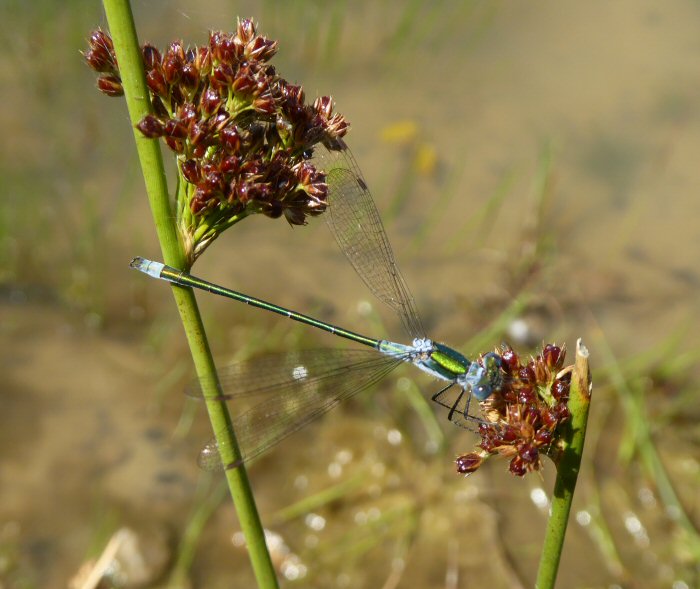
and the activities for children, Bug Detectives, on Wednesday 1st August. (Booking is essential - thank you)
Walking back along a net ride, I spotted a movement in the grass and tried to take a photograph of a very active female Great Diving Beetle. Many people assume that these insects must live in water. This is true of the larval stage but not of the adult. Adults can walk and fly from pond to pond.

They prefer ponds rather than running or moving water of streams and becks. Some invertebrates do require fast moving water as it has more oxygen contained in it. To find out more about our becks, there are two events supported by the Yorkshire Dales Rivers Trust Rivers 2U lab. More details on the events page and again booking is essential.
Changing topic completely, there was a lie in for the bird ringers this morning - a 0415 start! There was a hint of pink in the sky over the lake.
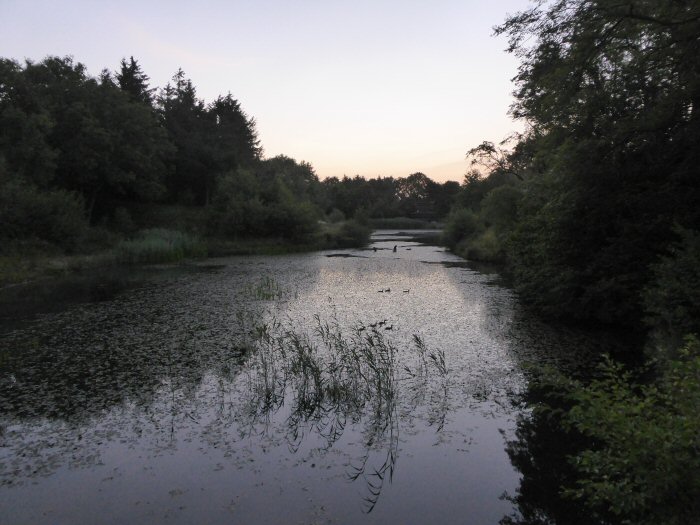
Children from Wavell School have been following the progress of the juvenile Robins, watching as they change their speckled breast for the red we are all so familiar with. This Robin was definitely showing more red than that shown a couple of weeks ago.

Most of the 150 birds processed were juveniles. Reed Buntings have been conspicuous by their absence but an adult male and this juvenile were ringed today.
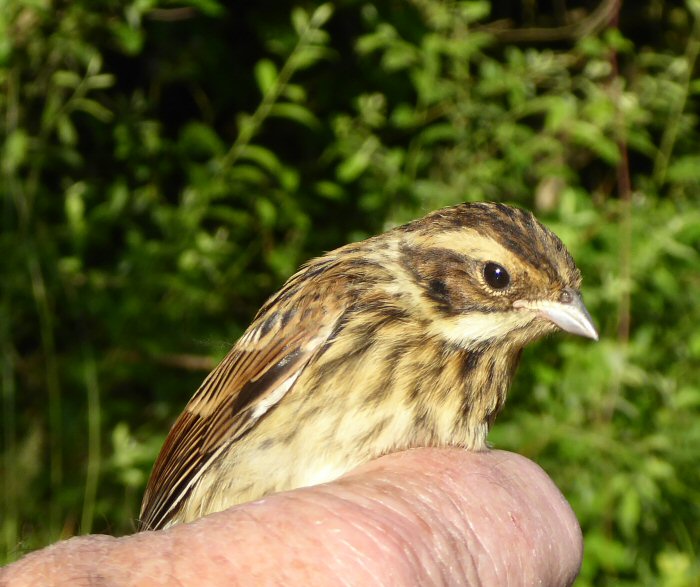
Great Tits have had an excellent breeding season and yet more were ringed today. Coal Tits are just beginning to return to the reserve where many will overwinter, eating the seed provided at the feeding stations, filled each week by Colin. Our summer migrants made visits to the ringing room: Blackcap and Garden Warblers were in evidence and it was nice to see the numbers of Willow Warblers and Chiffchaffs increasing.
As always to complete a CES day requires a team of people to work together and today was no exception. Thank you to everyone involved, only four more to go! Thanks and appreciation also go to those volunteers who have worked on the net rides and paths between them, to ensure that they are ready for use. The total of new birds ringed at Foxglove stands today at 61,662, but there are sheets of birds from this year still to be added when time permits.
Foxglove’s Marvellous Insects!
Saturday, July 14th 2018
This week the moth trap has been put out in the same place on three evenings and a different catch has been recorded each time. There were some moths that were present every time, Small Dotted Buff and Clouded Border giving the most numbers. Three Poplar Hawkmoths were in the trap this morning, only one on the previous nights.
Green Arches appeared twice. When newly hatched they are really green.
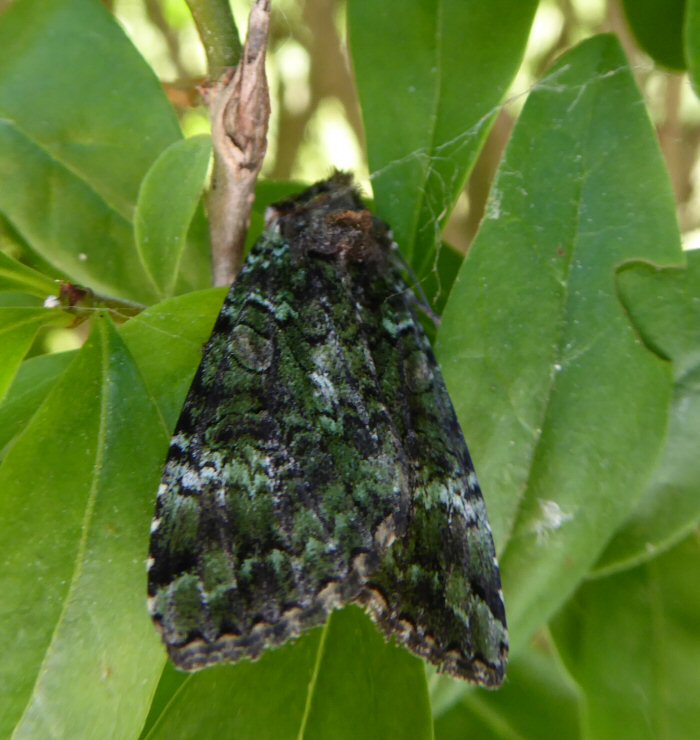
Coxcomb Prominent lives up to its name, but appeared only once.
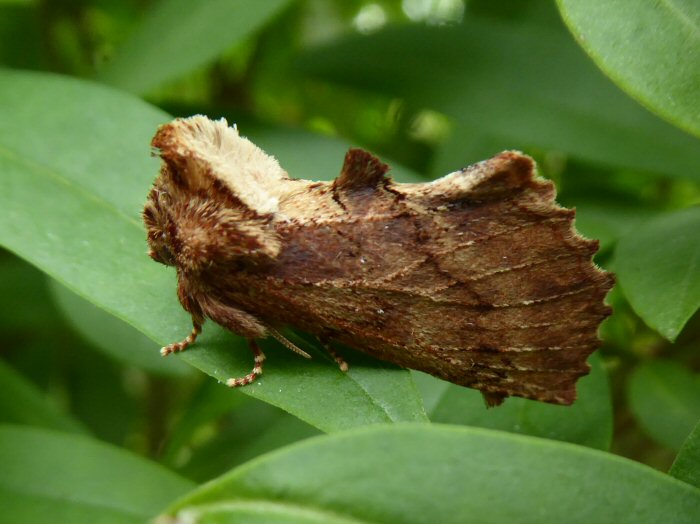
Whilst Beautiful Golden Y does have a gold mark on its wings, but what astonished me was the length of its legs.
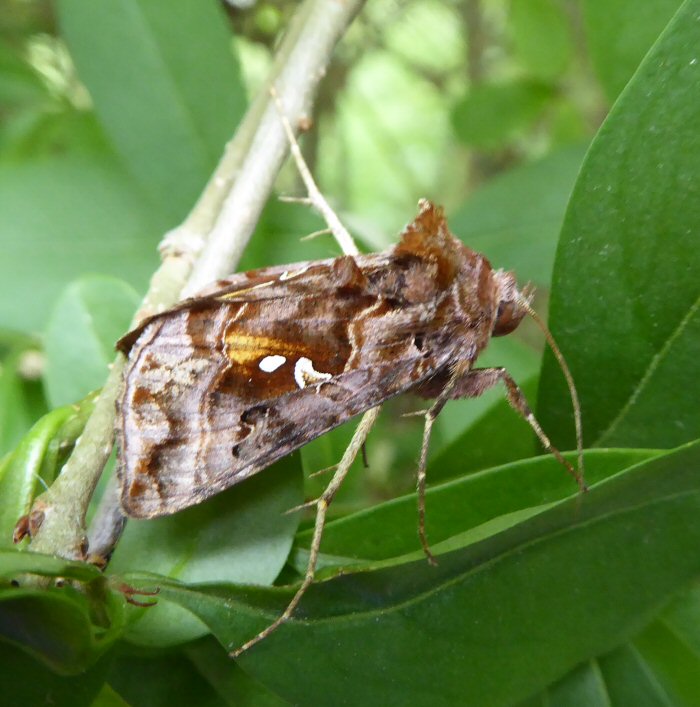
From moths to butterflies. Last year was a very poor year for Small Tortoiseshell butterflies but so far this year there have been several sightings.
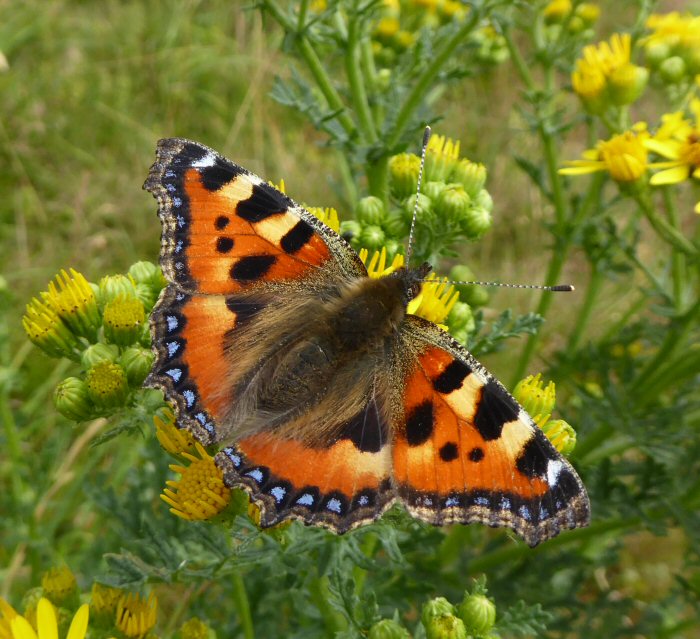
There was a hatch of Common Darters this sweek and several were photographed at different stages. The photographs are not very good as there was a lot of vegetation between me and the darters, but they do illustrate the change from an aquatic larva to an adult. When they emerge from their case the wings are tiny.
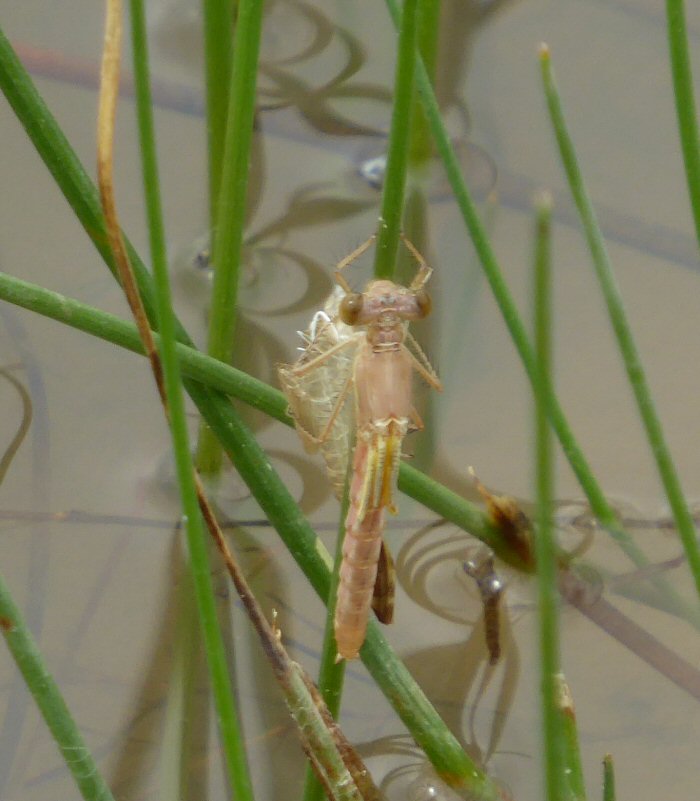
They then have to spend time enlarging their wings.
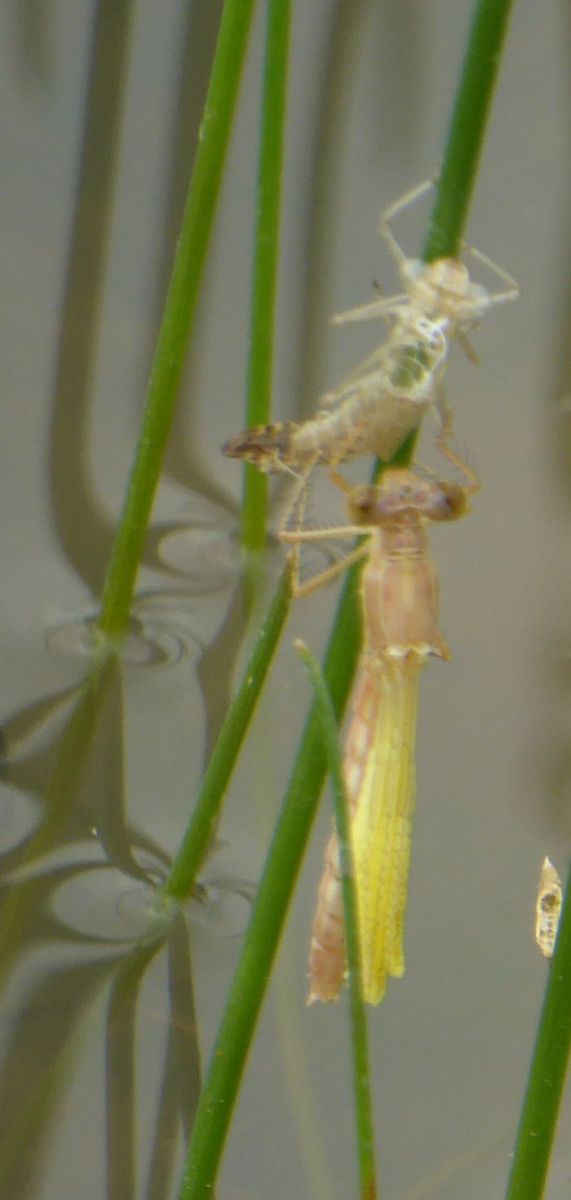
The wings have been fully stretched and you can now easily see the excuviae, the last larval exoskeleton.

And to complete the series of photos a Common Darter was hanging onto the rushes as the wind blew through them. His wings, which should have been at right angles on each side of its body, were almost all on one side!
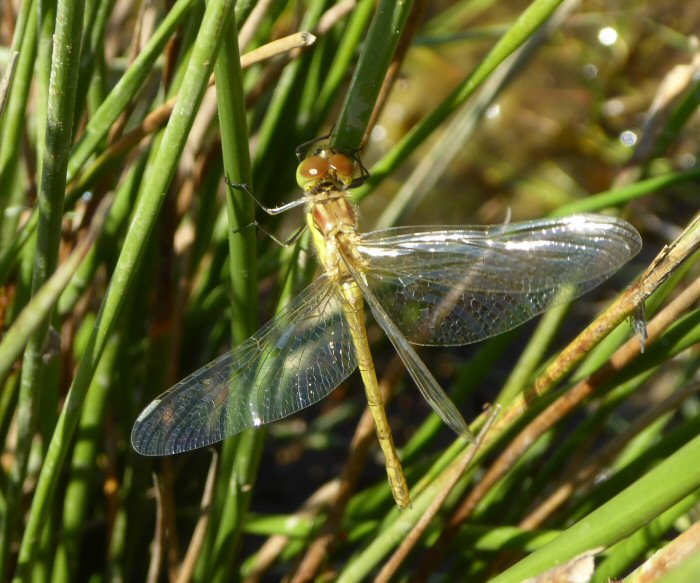
Leyburn Primary School visit Foxglove
Friday, July 13th 2018
Today we have been teaching children from Leyburn Primary School all manner of things from identifiying plants using different senses, to keystone species, and the many different trees of Foxglove.
Despite the weather the groups still found an interesting variety of bugs, beasties and underwater fauna with the grasslands of the Moorland proving most fruitful.
We've also been carrying out numerous little odd jobs around the school visit, including putting new signs up at each of the Pond Dipping platforms.
To everyone wanting to use the Pond Dipping platforms and bring their own nets please make sure to call the Reserve Managers ahead of time for tips on how to dip safely and reduce the impact dipping has on the natural environment.

Today was also Eleanor's last day of Work Experience with us, for which we're all greatly saddened.. She's put in a really good shift every day and we look forward to welcoming her back to the Reserve again in the future as a volunteer.
Bracken Bashing
Thursday, July 12th 2018
Continuing on with the theme of controlling unwanted vegetation; today we have been bracken bashing along the Coppice bank of Risedale Beck.

When left unchecked Bracken (Pteridium aquilinum) can take over the woodland understorey, shading out other species including the Bluebells (Hyacinthoides non-scripta) for which Risedale Bank is well known.

We have opted for Bracken bruising as the control due to its effectiveness, the reduced impact it has on other non-target species, and its suitability on difficult terrain.
Caught on Camera
Wednesday, July 11th 2018
Walking round the reserve often gives chance sightings of species which indicate how well they are doing. A quick walk across the Wetland to see how the weather has affected the flow of water through the area included the first sighting of a new Mallard brood carefuly navigating their way through one of the ponds.
But as we can't be in all parts of Foxglove all of the time, it's also useful to set up camera traps to see what's going on. The one that we have been using in Risedale Beck has been moved to the other side of the water as the vegetation had grown too high to allow good sightings. This has revealed just how much the side of the beck is used as a deer highway.

The cameras do take good quality pictures but have a fixed focal length, so cropping the image can help but may result in loss of resolution. The original picture above includes the time and date stamp for when this Roe doe and kid were first caught on camera and the one below has been cropped to focus on the two of them.

They were obviously very relaxed here as the camera trap, which is triggered by both movement and temperature change across the field of vision, continued to take pictures for over 5 minutes. By this stage the kid had lagged behind its mother and was clearly interested in exploring smells and sounds. Further images from this camera show the Roe Deer going back the other way along the beck this morning, although these are not very clear with the animals movements being blurred.

Given how often the Roe Deer have been now been caught on camera in Risedale Beck, it's not really a surprise to come across them for real with a kid grazing contentedly before realising that I was within 10 metres this morning. This resulted in a very rapid departure!
Vegetation bashing by the Scrapes and Lake
Tuesday, July 10th 2018
We started our day moving Lark and Taurus across the road to one of the other Heath paddocks, and after a few false starts they were both happily munching on pastures new.

After the early morning excitement of moving ponies we cleared back Net Ride 36 ready for bird ringing activities this Sunday, when Eleanor happened upon a leaf sporting interesting swollen red spots and aecia (specialised reproductive structures that produce aeciospores). These most likely belong to the Puccinia genus of fungi, all of which are plant pathogens and more commonly known as rusts.


Aside from tackling the encroaching vegetation on Net Ride 36 we have also been scrub bashing on the Scrapes and by the Lake, where Peter happened upon another rust coloured being within the stem of a Thistle.

This red cocoon looks similar to that of the Angle Shades moth (Phlogophora meticulosa), however I would not want to be held to this identification as there could be any number of moth cocoons that look similar to the untrained eye.

Dung Beetles
Monday, July 9th 2018
Before we get onto Dung Beetles of the UK I must make mention of the kids from Great Smeaton School who found one during today's Mini-beast Hunt. Aside from searching for Scarabs the group also took part in Pond Dipping, Habitat Walks and Scavenger Hunt activities throughout a fun-filled day at Foxglove.

We had yet to reach the Outdoor Classroom to begin hunting for Mini-beasts when the best of the day's bugs was found.
I am yet to work out which of the 60 species of dung-feeding Scarab Beetles this is, having narrowed it down to a member of the Geotrupes family.

Dung Beetles are grouped according to how they use dung, in Britain we have Tunnellers (Paracoprids) and Dwellers (Endocoprids), but lack the most famous of the groups known as Rollers (Telecoprids).
Tunnellers dig, burying the dung below ground, where they lay eggs and larvae develop. Dwellers generally spend their entire life in the poo, although the larvae of some species are found just under the soil surface.
The individual that the kids from Great Smeaton found was heavily laden with mites, which upon first glance may look to be a bad thing. However transporting mites that eat dung breeding flies is just one of many ecosystem services that these incredible Beetles carry out.
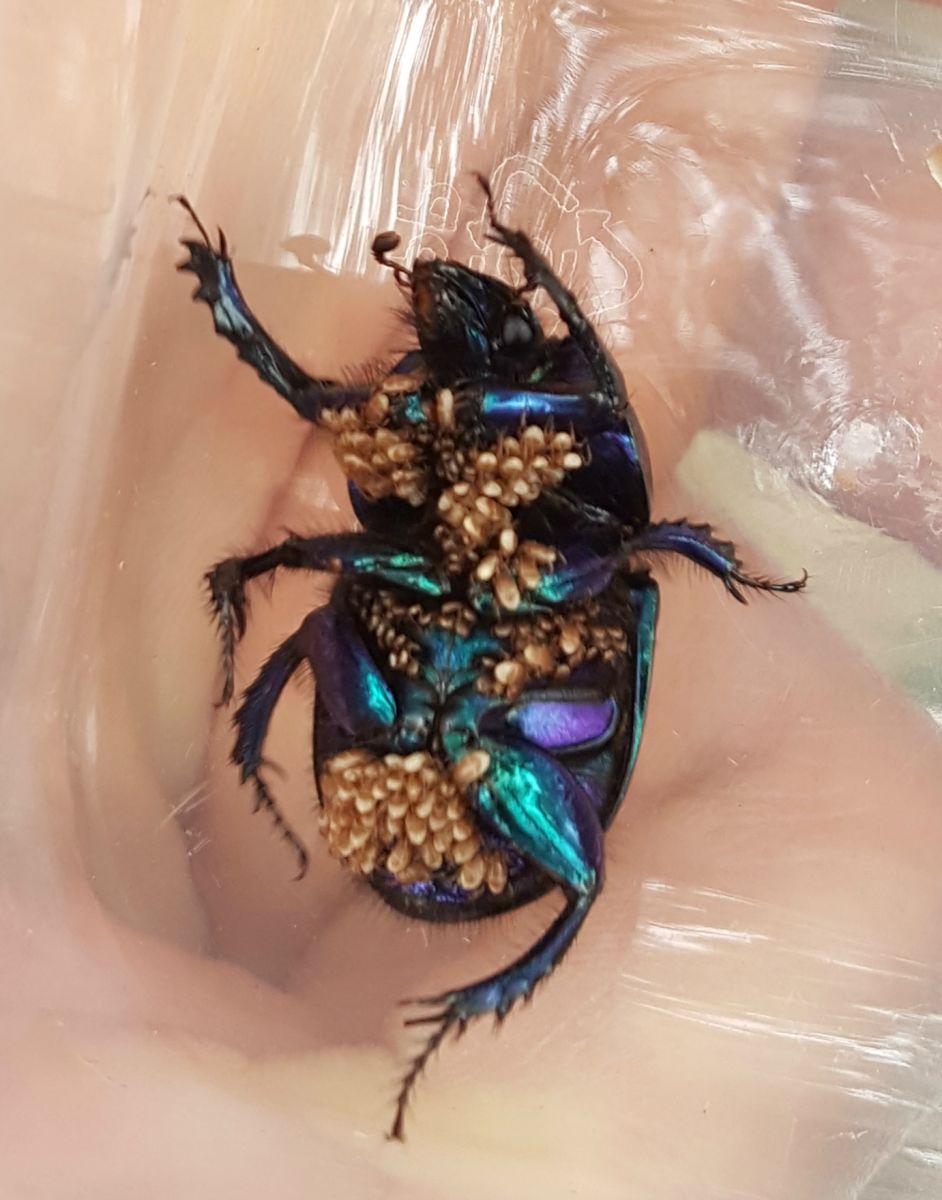
Dung Beetles also dispose of dung, fertilize soil through burying, act as a food source for birds and bats, enhance soil structure, reduce greenhouse gases and improve drainage (these creatures are truly amazing!).
Unfortunately British Dung Beetles are in decline for a number of reasons, including the overwintering of livestock away from fields,short term rotation grazing, removal of permanent pastures, chemical fertilisation of pastures, removal of dung and worming of livestock.
When you look at this list of reasons you quickly notice that they do not apply to the management techniques used here at Foxglove, which is why I hope to see more of these marvellous Mini-beasts in the future.

Over Half Way
Sunday, July 8th 2018
There are 12 CES days during the summer and today the seventh was completed. It was another busy day with most of the birds being juveniles. The adults are moulting and are hiding away. New birds outweighed the retraps today, with 167 birds receiving their rings whilst 97 had already been ringed. There was a Chaffinch that was eight years old, first being ringed in August 2010.
Bullfinches and Greenfinches numbers are slowly increasing. Willow Warblers are also doing well with 30 new ones ringed. It is definitely a Great Tit year with 26 new birds and 42 retrapped ones, many that were ringd in the nest boxes.
Whilst trying to photograph the 'dragons' (chasers and dragonflies) on Plover's Pool John noticed a bird of prey flying overhead. Once photographed and examined it was found to be a Hobby, which is a new species for the reserve.
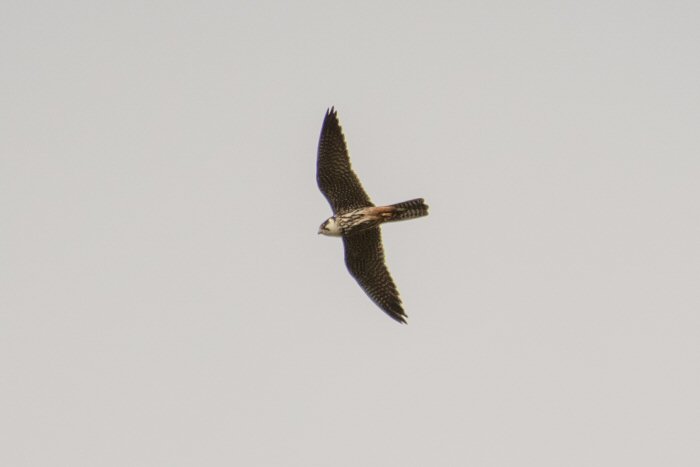
Almost a year ago to the day, Alicia found a Lunar Hornet Moth, at that time a new species for the reserve. Today Mark found one, only the second record. This group of moths are known as Clearwings. The larva burrow into the wood of tree trunks where they feed. Quite a ferocious looking character, mimicing a Hornet.
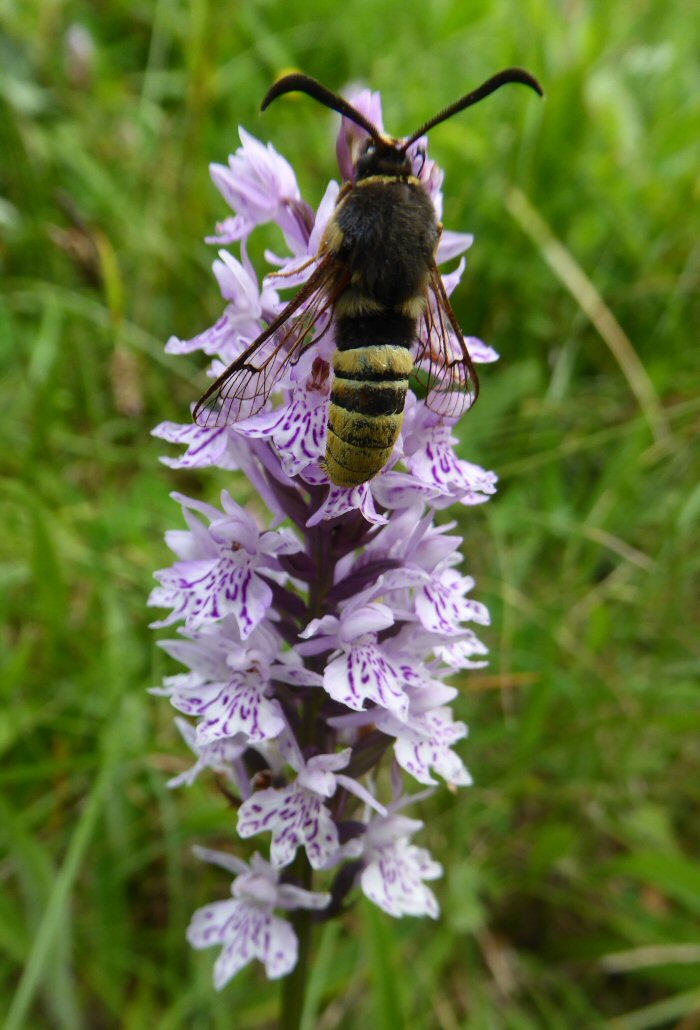
Always looking for something that does not 'look right' I noticed some small marks on a Silver Birch leaf. On closer inspection I found them to be the egg cases of Bronze Shieldbugs (I hope that I have the ID correct as they were very tiny.) If you look closely you can see that one has just hatched and its exo-skeleton has not hardened and darkened to its correct colour. You can also see the open egg case towards the right. These instars will shed their skin four or five times before gaining the adult shape and colour. The diet of these tiny creatures include vegetation but they also enjoy caterpillars.
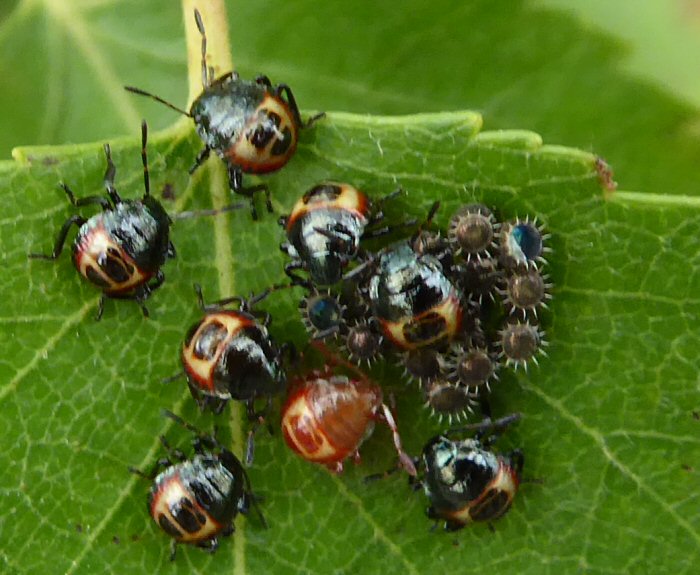
The warm weather is hurrying the flowering plants along. Common Centaury, another plant spreading its range, was hidden away in the verge grasses.
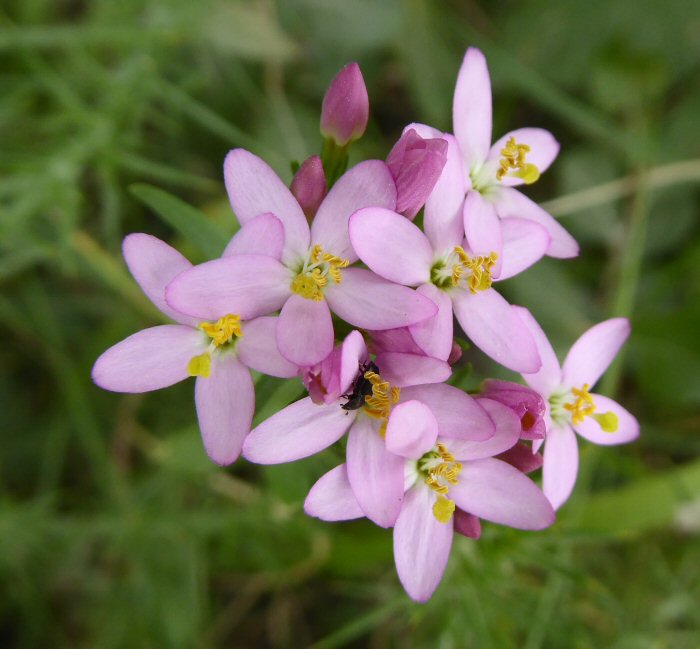
Marsh Woundwort is flowering in the Scrapes.
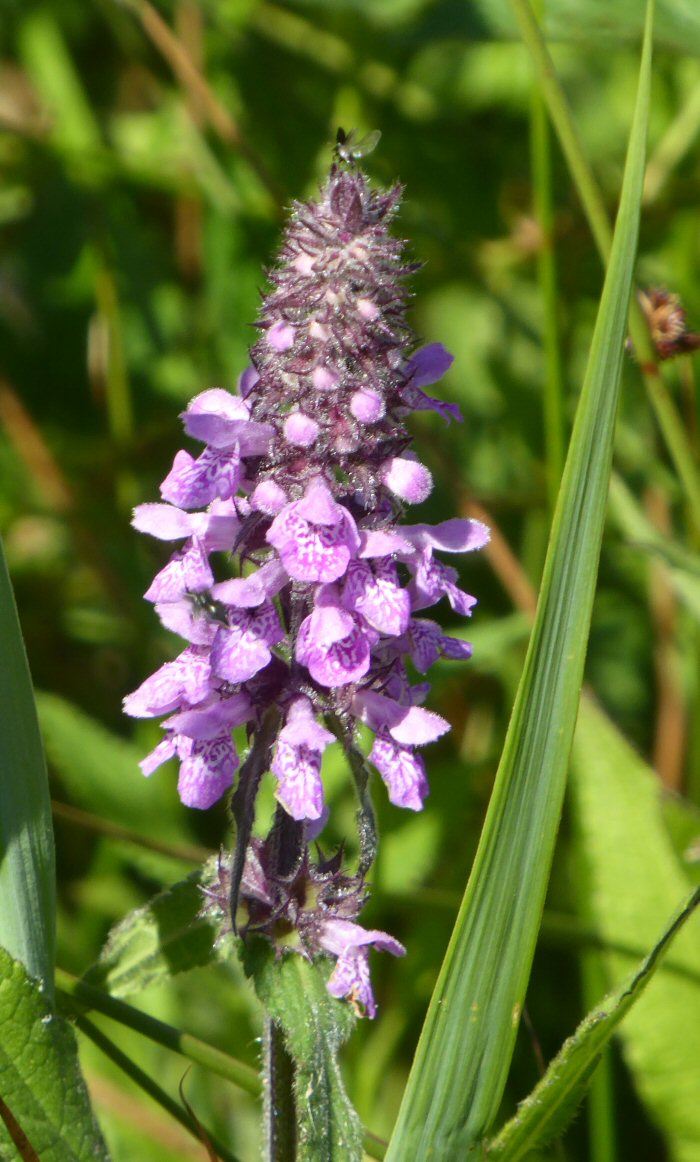
And the first head of Pepper Saxifrage is also open and was quickly covered in pollen beetles, followed by the carnivorous Soldier Beetle.

Common Water Crowfoot never looks 'posh' as do most flowers but this is a much better photo than some that I have taken. It is flowering in the Scrapes and this year has many more flowers than it has had in the past.
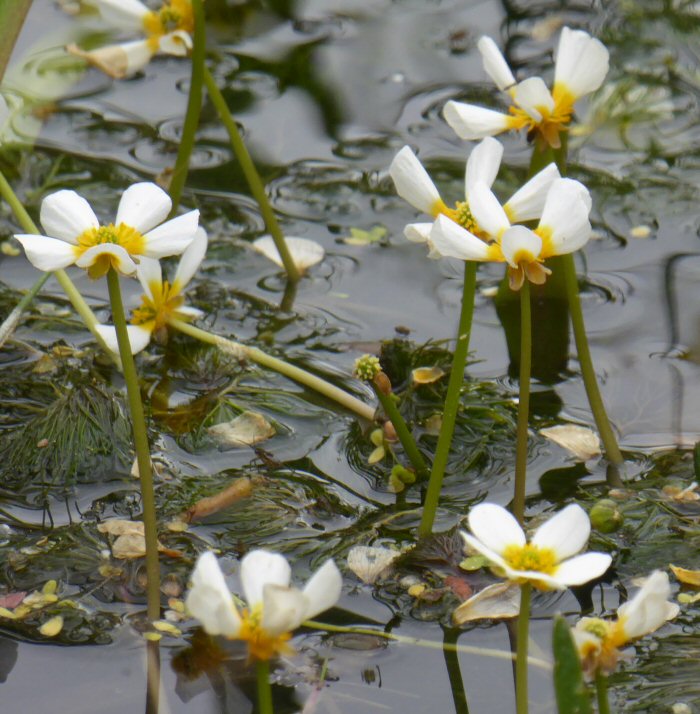
It was another busy day with 264 birds processed making it the 5th best CES 7 in 26 years. Thank you to everyone involved. CES requires much commitment and hard work from all of the team and the volunteers who work behind the scenes on the net rides, not just in the summer but the winter also.
CES 8 allows us to have a little longer lie in, a 0415 start, instead of 0400.
Butterflies Galore!
Saturday, July 7th 2018
Over winter those of us who like our bugs complain about the cold and the fact that there are very few multi-legged creatures moving around. As it warms up so the bugs begin to appear. Most of the insects appreciate the warm weather and the sunshine. Those of us who like bugs complain that it is too hot and the said bugs and insects never sit still, but with a little patience, a quick click and the insect is captured on camera.
I have seen the Common Blue butterfly flit away into the distance but I spotted one and followed it in the hopes that it would land and so it did.
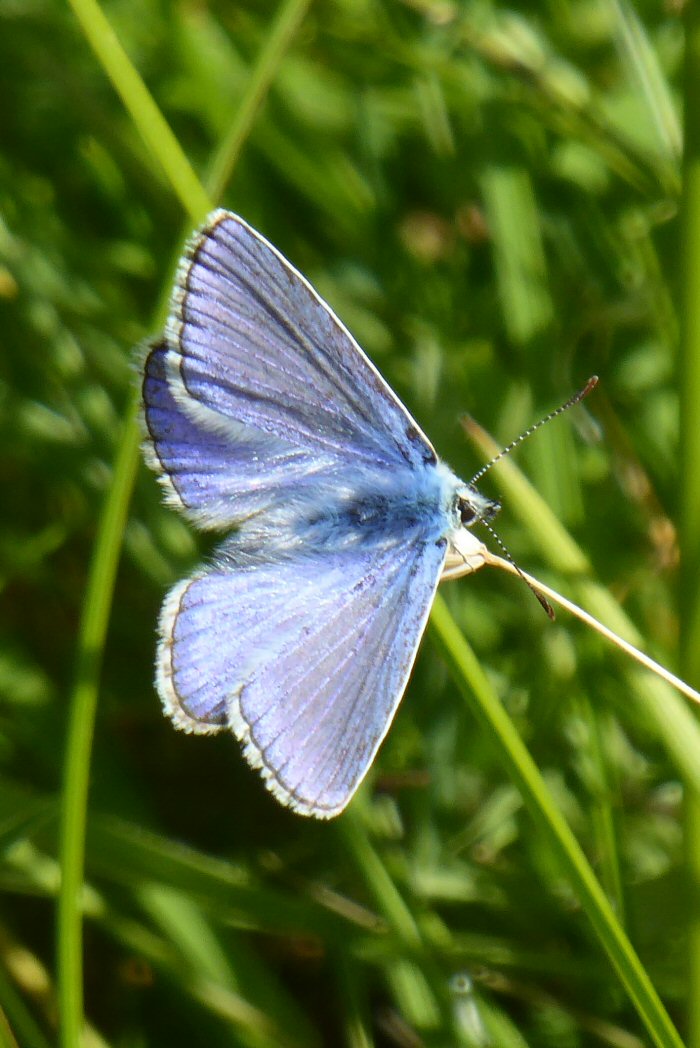
Not only was I able to take it with its wings open, which is unusual I also managed to get its wings almost closed and it showing off a rather furry abdomen.

Ringlet butterflies are everywhere on the reserve. Some have been very dark and we assume that these are freshly hatched ones. Blackberries often get called a variety of names by the volounteers during the winter as they are tripped up and scratched by them. During the summer they seem to grow across the paths as you look at them! But they are full of flowers at the minute and are covered in bees, hoverflies and butterflies. This Ringlet sat perfectly still.
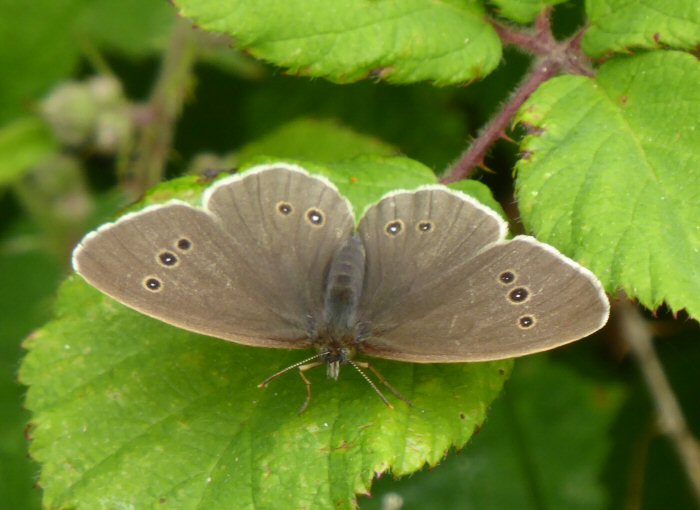
Comma butterflies were seen last year but I was not lucky enough to catch one, but this year several have been seen already.
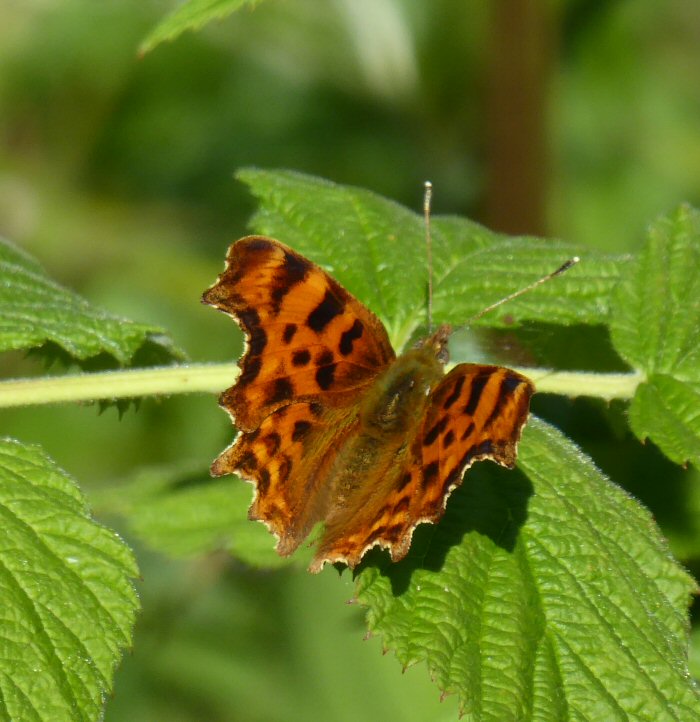
Dark Green Fritillaries were rare sightings several year ago, now they are more frequently seen. Unfortunately that pesky vegetation was in the way again!
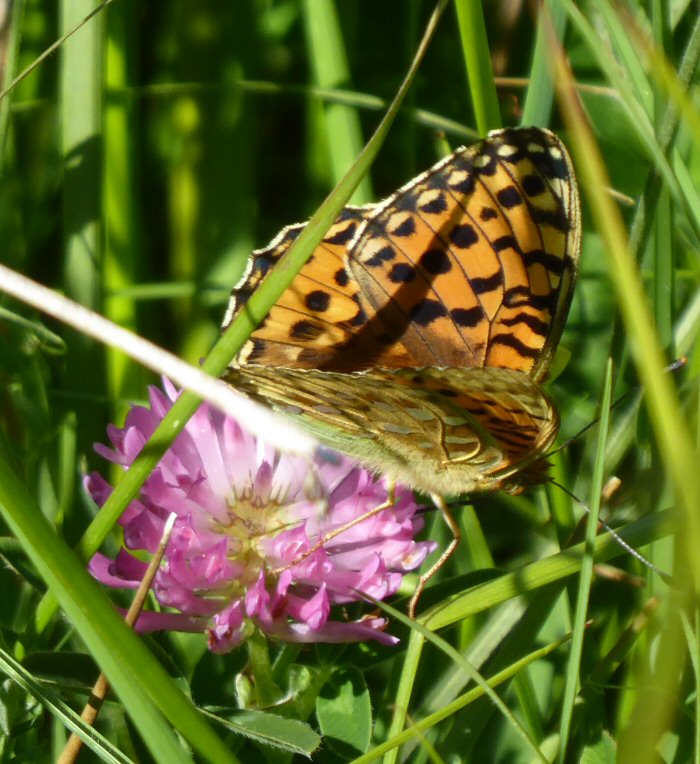
Talking of vegetation, Common Spotted Orchids are appearing in many new places yet again this year. Many thanks to the volunteers who are strimming around the orchids!
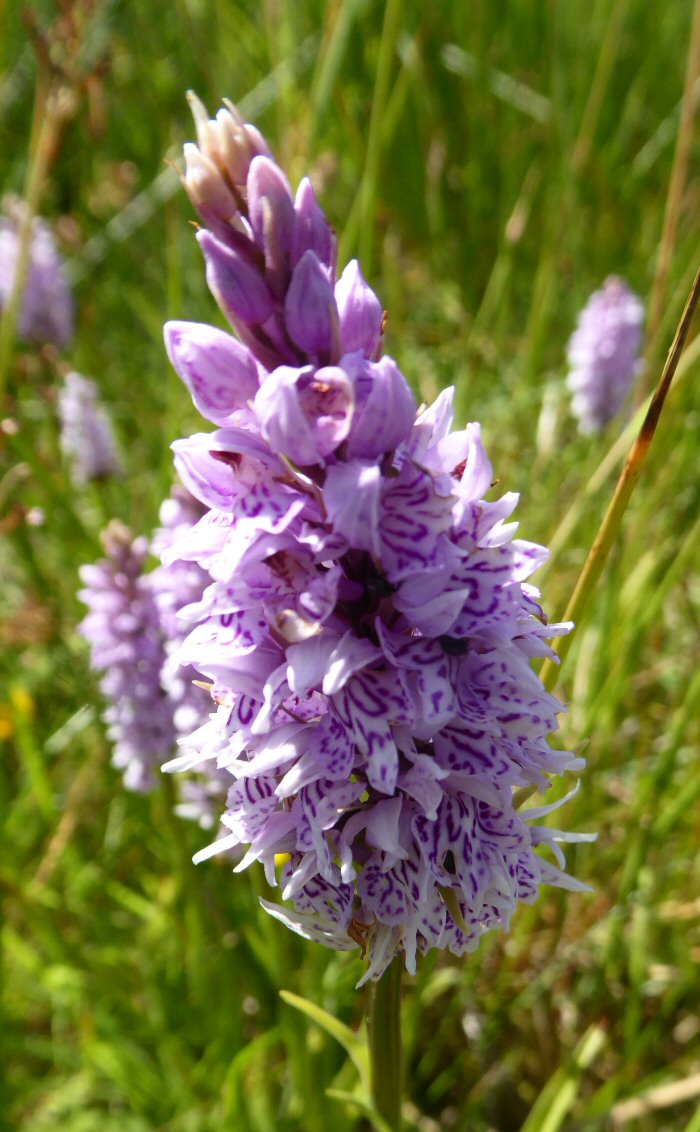
Yorkshire Countrywomen’s Association
Friday, July 6th 2018
I combined this morning's usual trip to see the ponies with putting up some new interpretation boards detailing interesting facts and figures of lowland Heaths in the UK, including information regarding the continued maintenance work carried out by Lark and Taurus.
.jpg)

Meanwhile Colin was busy creating more Mink Rafts in the Workshop where I joined him before too long to continue painting and decorating.
On my travels I couldn't help but admire one of our most persecuted plants; like many other wildflowers, Ragwort is poisonous to animals. This poses a problem if it gets mixed into dry hay that is later fed to livestock. In fields however, livestock will avoid it in its green state, and it is in fact mildly poisonous.
One thing that is rarely mentioned is the benefit of Ragwort to nature as a great source of food for pollinator species, such as bees and butterflies (much the same as the equally persecuted Thistle). On top of this there is also the fact that Ragwort is the principle food source for the Cinnabar moth caterpillar (seen below). In the UK the exceptionally vibrant and wonderful Cinnabar moth has seen a dramatic decline of 83% in the last 35 years!

It's now safe to return to reading the blog after my mini rant on persecuted plants (sorry!), and just in time to make mention of our visit by the Yorkshire Countrywomen's Association who enjoyed a talk regarding the Reserve led by Steve, before an extended guided tour taking in all of the wonderful habitats that make up Foxglove.

RAF Leeming CPS: Part 2
Thursday, July 5th 2018
Today we had the second half of our visit by RAF Leeming Community Primary School. The other half of reception enjoyed a slightly altered Scavenger Hunt in the afternoon, as well as a morning jam packed with Mini-beast hunting and Pond Dipping.
Many of the usual suspects were caught at the Pond Dipping platforms on the Scrapes, such as this freshwater snail.

There are around 40 different kinds of water snail in the UK, from tiny Nautilis Ram's-horn (3mm across) to the relatively huge Great Pond Snail (4cm in length).
Even new ponds are soon colonised by water snails, most of which are carried accidently by birds, and occasionally amphibians. Other methods of colonisation often involve the sticky eggs attached to bits of plants that can be easily moved from pond to pond, or which will often flow downstream.

Aside from our visit from RAF Leeming, our Thursday Volunteers have been busy repairing boardwalks in the conifer wood above Risedale Beck, cleaning signs, and filling bird feeders.
RAF Leeming Community Primary School
Wednesday, July 4th 2018
Today we were joined by children from RAF Leeming CPS, who enjoyed a fruitful morning of Pond Dipping and Mini-beast Hunting despite the cloudy start to the day.
Amongst the rotting wood and leaf litter was found a number of Violet ground Beetles (Carabus violaceus). Although a nocturnal hunter of many smaller insect species, you will often come across this large and very fast beetle when turning over stones and logs during the day time.

After turning logs and shaking branches it was time to head out into the long grass of the Moorland to have a go at sweep netting.

It wasn't long before all manner of mini-beasts were caught, from grasshoppers to butterflies and even a couple of day-flying moths. The Six-Spot Burnet moth (Zygaena filipendulae) is especially fond of Thistles, Knapweeds and Scabious as adults, whereas Common and Greater Bird's-foot Trefoil are the host plant of the caterpillar.

In the afternoon Caitlin (our current Work Experience pupil) was busy renovating the last Water Vole platform, before getting two of the benches painted, ready for them to be put back outside tomorrow.

Water Voles on the Wetland
Tuesday, July 3rd 2018
A number of different practical tasks have been going on all at once today; with some people strimming on the Wetland, others repairing boardwalks, and a few cutting vegetation back from the perimeter fences.
The best find of the day has been yet more evidence of the Water Voles on the Wetland, who have decided to use critical apparatus designed to maintain water levels across all of the ponds as a latrine.
Meanwhile, John has been collecting manure for his gardens, with Lark only too happy to help with the process (apparently mixing with water makes quite the fertilizer).

We've been removing a lot of vegetation from around the perimeter fence just past the access gate, this not also removes security risks to the garrison, but also 'lifts' the vegetation from around the track aiding drying in wetter months (often the first port of call when you're called out to deal with a path that is often muddy and wet in winter).

Vole Platform Remodelling
Monday, July 2nd 2018
This week we will be joined by Caitlin, our fourth student carrying out work experience on the Reserve this year.
After a quick tour of the Reserve we started on our daily and weekly checklist, including feeding and watering the ponies, checking mink rafts for tracks and signs, and cleaning hides.
After a quick break it was back to the Workshop to begin the process of remodelling our Vole platforms.

As the original vole platforms are made of marine ply we decided on remodelling rather than replacing, and set about increasing their buoyancy.

It wasn't long before we had three more Vole platform completed, with two going back onto the Scrapes…

And one being put back onto the Wetland, where we spotted signs of Water Vole activity in the form of bite marks in the apples that had been put out by Colin last Friday.

CES 6 - A Great Tit Day Amongst Other Things!
Sunday, July 1st 2018
By 0400 we were all in the ringing room collecting bags, papers and nets getting ready for CES 6. It was cool and the lake had small clouds of mist hanging over it, as the sun rose.
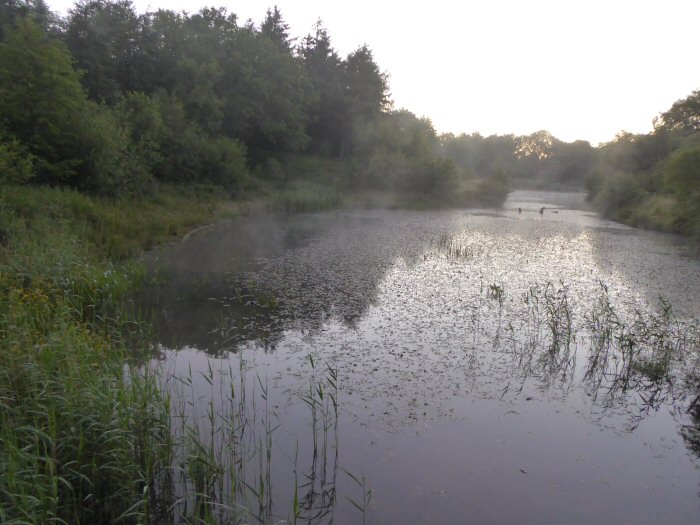
At the early hour it is interesting to check the Field Centre wall for moths. A Poplar Hawkmoth was rescued as it was very close to a spider's web. When placed on a tree leaf it held its wings open, so its red warning flashes could be seen.
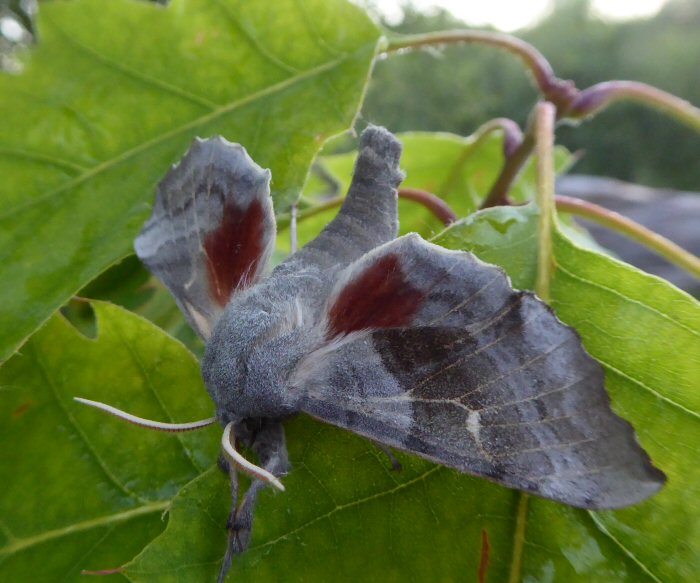
Net rounds were carried out and many birds arrived in the ringing room, including a juvenile Robin with more red feathers than two weeks ago. In all 12 new Robins were ringed.
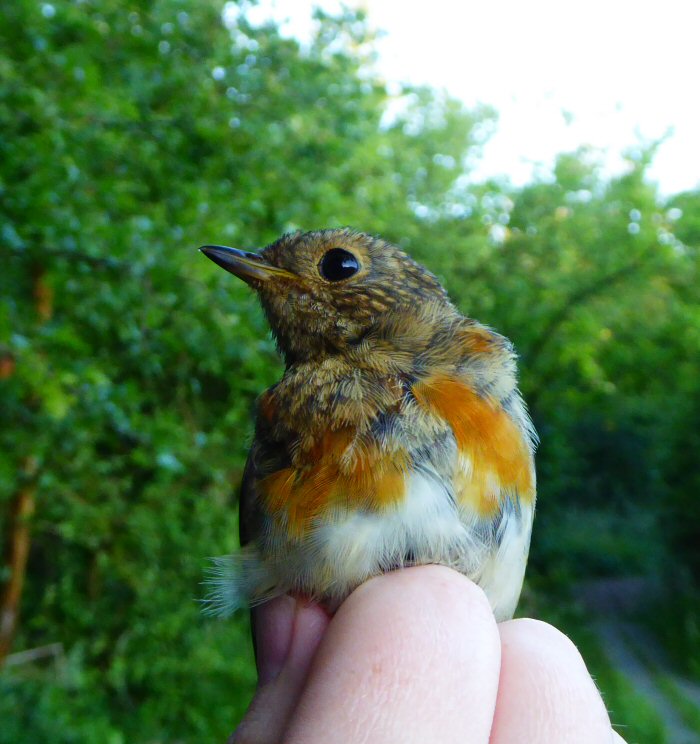
A call on the radio warned ringers to tread carefully over the weir as there was a 'hatch' of Common Frogs leaving the lake. I went hunting for them and could see none, so I thought that they had all dispersed but as I stood still, the ground started to move as tiny Common Frogs were hopping and walking around in the undergrowth.

A walk through the Scrapes and something was on the Water Vole raft, a young Moorhen having a really good feed of the apple!
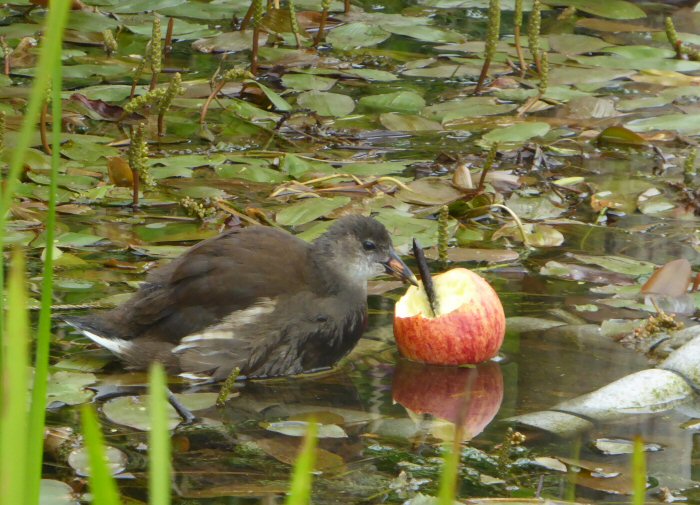
Back in the ringing room a Tawny Owl was retrapped. This was a stunning bird. When released it flew away on silent wings.
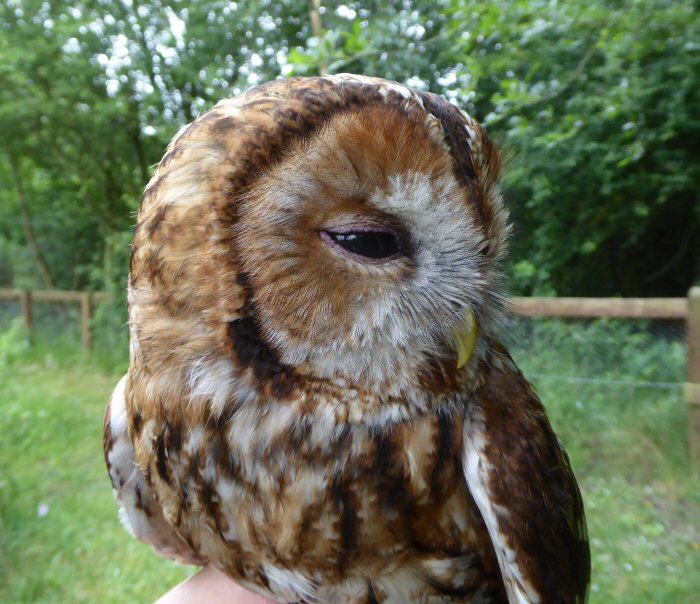
Tawny Owls regularly use our special nest boxes to rear their young. There are Barn Owls on the training area around Foxglove but this year is the first time that they have bred on the reserve. The three chicks at three weeks old were old enough to ring. They will probably remain in their nest for at least another three weeks.

Juvenile Long-tailed Tits were processed and are just a little smaller than the owls ringed!
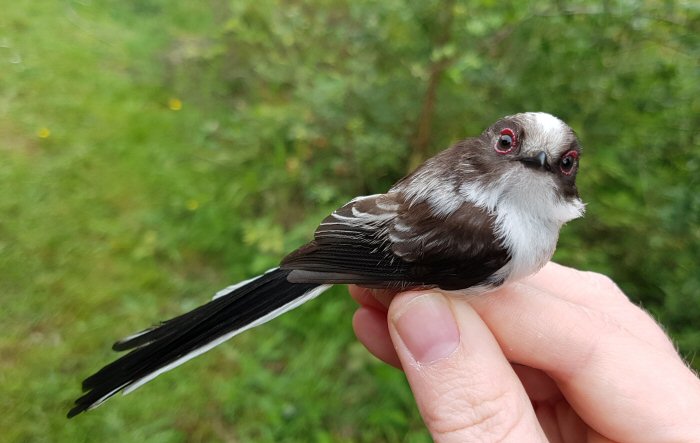
Mrs Tufty Two was relaxing with her youngsters on the tree in the lake.
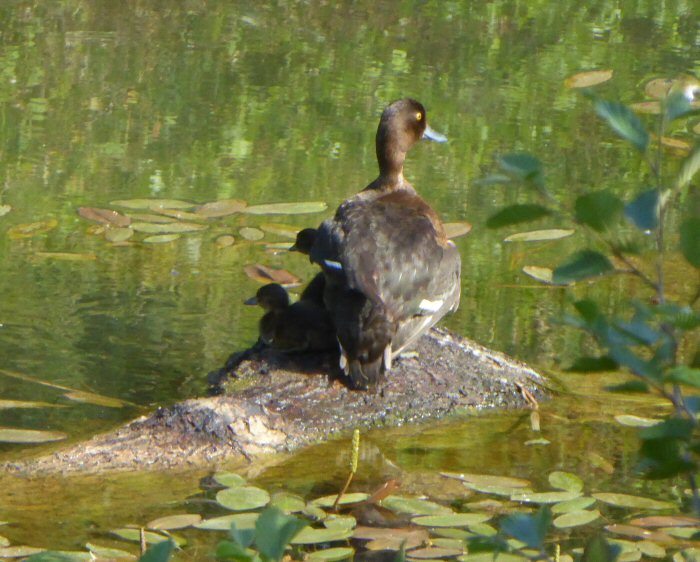
I was pleased to see Pisaura mirabilis last week and even more pleased when I spotted several webs today. A photograph enlarged, amazingly, shows spiderlings inside the protective web.
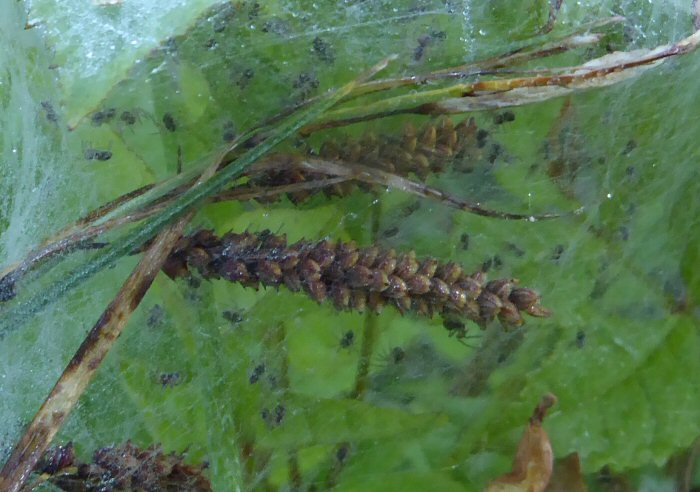
After ten and a half hours the nets were taken down, numbers crunched and it was found to be the second biggest catch for CES 6, with 253 birds processed. In 2006, we caught 274.
In the total 24 new Great Tits were ringed and 53 were retrapped. Most of these birds were juveniles. Chaffinch and Bullfinch numbers were higher than of late. It was a real pleasure to see 32 new Willow Warblers ringed. Some of the juveniles were already beginning their post juvenile moult. Many adult birds are now hiding away as they moult, after working hard to rear their young.
Such a busy day would not have been successful without all the help and support from the bird ringers, volunteers who prepared the net rides and those who provided food and cups of tea. A huge thank you to everyone.












